
Document 1
MEMO
To:
El en MacGregor-Reid
From:
Jackie Talbot
CC:
James Gavey, Rebecca Frankum, Lauren Burr
Date:
8 October 2019
Subject:
Update on Review of Achievement Standards – process to confirm subjects
Purpose
1.
Cabinet agreed in-principle to a number of changes to NCEA, including
• NCEA Level 1 focused on a broad (foundational) education;
• Fewer, larger standards.
2.
Al of the current standards are due for review at the end of 2020, with a view to them expiring
from 2022.
3.
In order for the changes to be enacted and for Level 1 to meaningfully be a broad, foundational
qualification, there needs to be fewer subject options at Level 1. To begin the process of
reviewing and updating the achievement standards in line with this vision, we need to confirm
which subjects we wil support. The process by which we determine this needs to be
transparent with valid opportunities for the sector to contribute.
Recommendations
Agree that we will seek expressions of interest and form all Subject Expert Groups (SEGs) for
existing groupings of New Zealand Curriculum achievement standards in 2019.
Agree / Disagree
Agree that we will conduct a two–phase engagement process, with the first phase occurring in late
under the Official Information Act 1982
2019 focussing on the role of subjects within NCEA, and with the second phase in early 2020
focussing on the provisional list of Level 1 subjects.
Agree / Disagree
Agree that we wil hold face-to-face engagements with selected SEGs in 2019 to gain their input and
advice on the subjects that wil be developed during the RAS.
Agree / Disagree
Released
Note that this memo wil be followed by a Communications and Engagement Plan, which will include
more detail around who wil be involved, when and through what mechanisms.
Memo
Requirements of the process
4.
To rebuild Level 1 as a broad, foundational qualification to be trialled in 2021 and fully
implemented in 2022, the Level 1 achievement standards wil need to be reviewed in 2020. In
order to do this, we wil need to finalise the Level 1 subjects and SEGs in time to begin work
in May 2020.
5.
The process by which we do so wil need to be transparent, providing the sector with a
meaningful opportunity to share their views.
6.
Key stakeholders (including subject associations, iwi, peak bodies, tertiary providers, careers
advisors, the Pathways Advisory Group and key employer networks) wil need to be informed
at key points and have opportunities to contribute to the process. We wil also require the
Minister to approve the process for deciding the subjects which we intend to develop through
the RAS, and to take note of the final list.
Proposed SEG formation approach
7.
We are calling for expressions of interest for SEGs for all existing groups of learning using New
Zealand Curriculum (NZC) achievement standards in October, excluding te reo Māori which
wil undergo a parallel process led by the ākonga Māori team. This wil go out through the
Education Gazette and relevant channels and networks.
8.
There is a parallel process for all of the Te Marautanga o Aotearoa derived standards which is
being led by the ākonga Māori team. The Level 1 standards wil be developed along similar
timelines to enable them to be ready for trialling within schools in 2021.
9.
The membership of SEGs wil be confirmed in November and members of selected SEGs wil
be invited to participate in face-to-face engagements and provide advice to the Ministry on
subjects. SEGs for which the subject is likely to change or be merged at Level 1 wil be given
priority for participating in face-to-face engagement.
10. To fulfil the vision of a broad Level 1 qualification, some subjects may be merged or combined
at Level 1 with specialisation occurring in later years. In these instances, some SEGs may be
combined or may work in conjunction with each other or with Reference Groups.
Proposed engagement approach
11. We are proposing a two-phase engagement approach.
under the Official Information Act 1982
12. Phase one:
• Wil specifically reach out to the key stakeholder groups in advance of public
engagement (including the RAS reference group and chairs of the relevant subject
associations, PPTA, SPANZ, SPC, NZPF, TRN, NKAI, iwi, Universities NZ, the
Industry Training Federation and ITOs, institutes of technology and polytechnics,
employers, and PTE peak bodies)
Released
• Engagement with iwi, wānanga, and other Māori stakeholder groups wil also be a
priority.
• Focus on subjects and their role within the different qualification levels of NCEA
Memo
• Emphasising Cabinet’s agreed purpose of each qualification and their enactment
through the outcome statements and subjects
• Will take place from late October 2019 through late January 2020
• Provides an opportunity to have genuine exploratory discussions around what kind of
learning should be taught in schools and what subjects should be offered
• Wil broadly be conducted online, i.e. with online information content and a
questionnaire for providing feedback
13. The processes for engaging with groups interested in supporting new subjects is being
finalised by the operational policy and ākonga Māori teams.
14. Phase two:
• Wil again reach out to key stakeholder groups, such as PPTA, SPANZ, SPC, NZPF,
TRN, NKAI, iwi, and the subject associations.
• More targeted and focused on the provisional subject list
• Will take place in February following the release of the provisional subject list
• The sector wil have opportunity to provide feedback through a second online
questionnaire until late March
15. We intend to publish a final Level 1 subject list with the sector in late March.
Preliminary approach for progressing new subjects for Levels 2 and 3
16. Throughout this process, we expect to receive diverse requests to establish new subjects or
create new standards. This wil be a genuine opportunity to have discussions around what kind
of learning should be supported through NCEA and how this might look as subjects or courses.
17. While we do not intend to support all possible subjects that may be requested, where these
subjects fit with the vision of NCEA Levels 2 and 3 as more specialised subjects preparing
students for their pathways, we wil identify relevant stakeholders to form Exploratory Groups.
The Exploratory Groups wil be formed between February 2020 and May 2020 and may include
industry, tertiary, subject associations and relevant kaitiaki of included knowledge bases.
under the Official Information Act 1982
18. In June 2020, as the Level 1 RAS is underway, we wil undertake workshops with Exploratory
Groups to firm up the desired significant learning of possible subjects and confirm an approach
moving forward.
19 In some instances, it may be appropriate to not develop new achievement standards for
subjects or courses, but rather develop curriculum content, assessment resources tied to
another subject (e.g. contextualised content for Physical Education to support Outdoor
Education), or resources to support coherent packages of industry-derived unit standards to
be delivered as subjects or in conjunction with other subjects.
Released
20. During this phase of working with the Exploratory Groups, we will liaise with GAVC, NZQA,
ITOs and the WDCs (as they come into force) where learning being considered for further
support through RAS may already be assessed through unit standards. Where appropriate
Memo
further support for these subjects is determined to not be development of achievement
standards, we wil continue to work with GAVC, NZQA, and the relevant standard-setting
bodies to explore options for progressing this support through RoVE and any development of
vocational standards.
Permissions environment
21. The attached annex outlines the proposed timeline.
22. The timeline for engagement for determining subjects includes the series of memos, brie ing
notes and education reports to ensure that each step of the process is clear.
23. STCH wil receive a memo on the list of SEGs we intend to form and the process for
determining which SEGs wil be formed first for the October 16 meeting.
24. The provisional list and final list wil both go through COG and STCH, before going to the
Minister in briefing notes.
Delivery risks
25. There is a lot of work to do in the early stages of this proposed approach. The potential risks
of this wil be exacerbated by a lack of personnel with communications expertise in early
October. This wil be mitigated by working with the Ministry’s communications team.
26. The proposed approach involves periods demanding high workload, including analysing
engagement outputs, conducting further engagement with key stakeholders (including iwi and
kura representatives), and undertaking the formation process of subject expert groups.
27. The proposed approach provides the sector with an opportunity to engage during November
and over the summer holiday months. The sector’s capacity and desire to engage with us may
be reduced, potentially prompting a negative reaction. To mitigate against this we wil ensure
it is straightforward for the sector to engage.
28. Given that we are likely to secure Cabinet’s in-principle agreement in December to progressing
the change package, there is a risk that the final Level 1 subject list announcement may get
bundled up in pre-Budget announcements, delaying publication. This is a particular risk in
cases where the development of new subjects requires additional funding to be announced.
Next steps
under the Official Information Act 1982
29. Once there is agreement to the high-level engagement process, we wil confirm the detailed
timeline based on the dependencies across the work programme (RAS timeline, access to
sector, engagement requirements, etc). This wil then be managed out of the engagement
team, in conjunction with the RAS project team.
30. We will also continue developing the communications and engagement material, tailored to
the final decisions, along with the subject evaluations and decision-making matrix, and
preparation for launching SEG expressions of interest.
Released
31. A full engagement and communications plan is currently being built. This wil contain more
detail of both the process and the responsibilities within and between the teams of Secondary
Tertiary.
Memo
Annex 1: Proposed timeline
Subject Expert Group
Engagement for determining subjects
Date
Request for Expressions of Interest content for Ed Gazette
4-Oct
(to be published on October 14th) and for the website to go
through internal permissions
Briefing Note to JT on engagement on NCEA
10-Oct
subjects
Memo to JT on the list of SEGs we intend to form and the
9-Oct
process for determining which SEGs wil be formed first
Memo goes to STCH on the list of SEGs we intend to form
11-Oct
and the process for determining which SEGs wil be formed
first
Request for EoIs for SEGs published in Ed Gazette and online
14-Oct
Briefing Note o Ellen MacGregor
14-Oct
(closes 25th October)
Memo presented to STCH on the list of SEGs we intend to
Briefing Note to the Minister (alongside the
16-Oct
form and the process for determining which SEGs wil be
16-Oct
requested information on NCEA)
formed first
Public facing engagement doc and col ateral to JT
22-Oct
Public facing engagement doc and col ateral to
24-Oct
El en
Engagement Phase 1 begins: Publish public-facing
engagement document outlining our thinking of a
broad qualification at Level 1, includes
29-Oct
opportunities for the wider sector to engage e.g.
questionnaire (engagement period closes 24th
January)
Ministry has internally determined which SEGs wil be
prioritized for early formation to enable face-to-face
25-Oct
engagement to provide advice on the place of their subject
under the Official Information Act 1982
within NCEA
25-Oct
Request for EOI for al SEGs closes
25
October – Ministry works to select members for the SEGs (on a rol ing
7
basis)
November
Released
Ministry has determined make-up of priority SEGs, notified
them and invites the members of the SEGs for face-to-face
8-Nov
engagement occurring from the 18th November to 11th
December. Face-to-face engagement provides opportunity
for SEGS to feed into thinking on subject list in an advisory
Memo
capacity. They wil also be given the opportunity to submit
recommendations (as an individual or col ective) by 24th
January.
Ministry has a clear evaluation matrix for determining which
subjects should exist (and at what level). This can be used as
11-Nov
a basis for face-to-face engagement with SEGs and wil be
used in the decision-making process of
establishing/merging/disestablishing subjects.
Face-to-face engagement with select SEGs begins – provides
18-Nov
opportunity for SEGs to feed into thinking on subject list
(advisory capacity only)
Remaining successful SEG members notified and paperwork
5-Dec
for probity checks begun
13-Dec
Face-to-face engagement with SEGs ends
4 January -
Preliminary analysis of engagement outputs
24 January
Engagement Phase 1 ends: questionnaire closes,
24-Jan
all recommendations for subject list due in
Analysis of engagement outputs for devising
27 – 31
provisional subject list and writing a fol ow-up
January
Briefing Note to the Minister
Internal permissions for fol ow-up Briefing Note
Week of 3
informing the Minister of intent for provisional
February
subject list and provisional subject list to COG and
(TBC)
STCH
Fol ow-up Briefing Note to Minister informing on
10-Feb
the intent for Level 1 provisional subject list
Engagement Phase 2 begins: Publish public-facing
Inform the sect r hat the Level 1 SEGs wil be made up of
engagement document outlining our intent for
17-Feb
representatives from existing SEGs where subjects are
Level 1, the provisional subject list, including
17-Feb
combined
opportunities for the wider sector to engage
(closes 6th March) e.g. questionnaire.
under the Official Information Act 1982
Engagement Phase 2 ends
6-Mar
Analysis of engagement outputs / putting together 9 - 13
final list of subjects
March
Internal permissions for Briefing Note informing
Week of 16
the Minister of the final subject list and final
March (TBC)
subject list to COG and STCH
Released
Briefing Note to Minister informing of the final
23-Mar
subject list
Memo
Confirm make-up of al Level 1 SEGs, including those for
30-Mar
merged subjects, and the make-up of the reference groups
Share final list of Level 1 subjects with the sector
30-Mar
to support those SEGs
under the Official Information Act 1982
Released
Memo
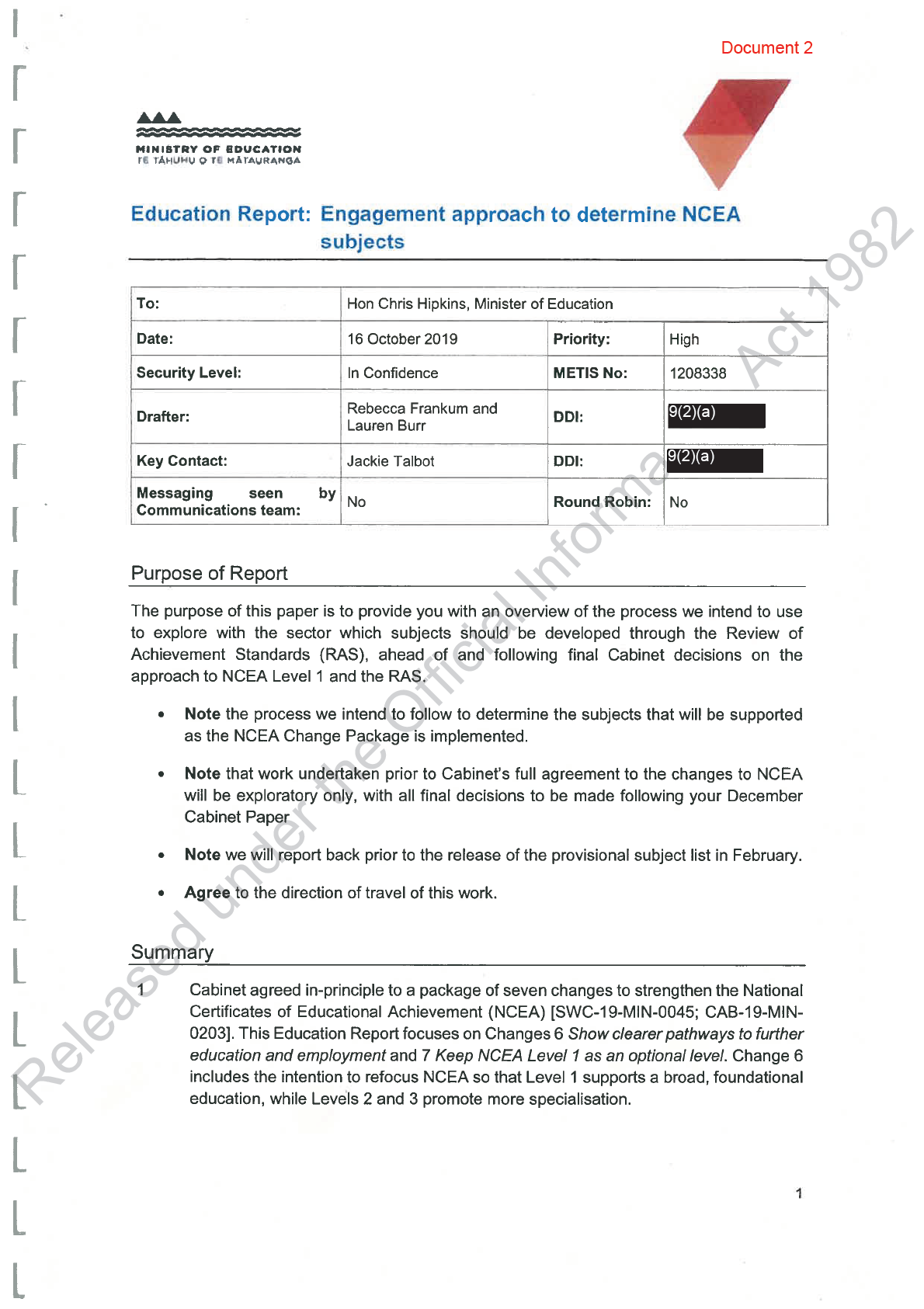

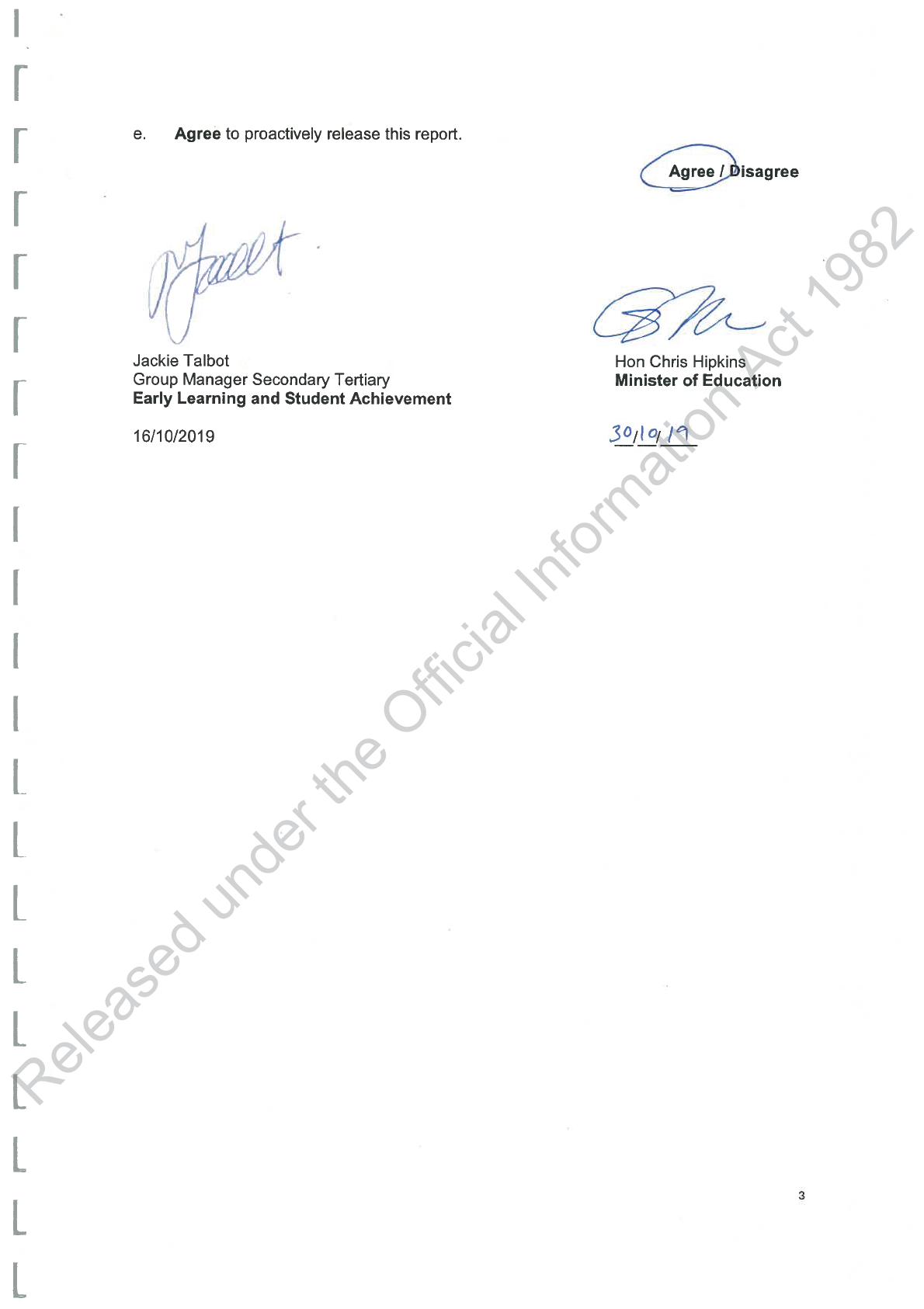
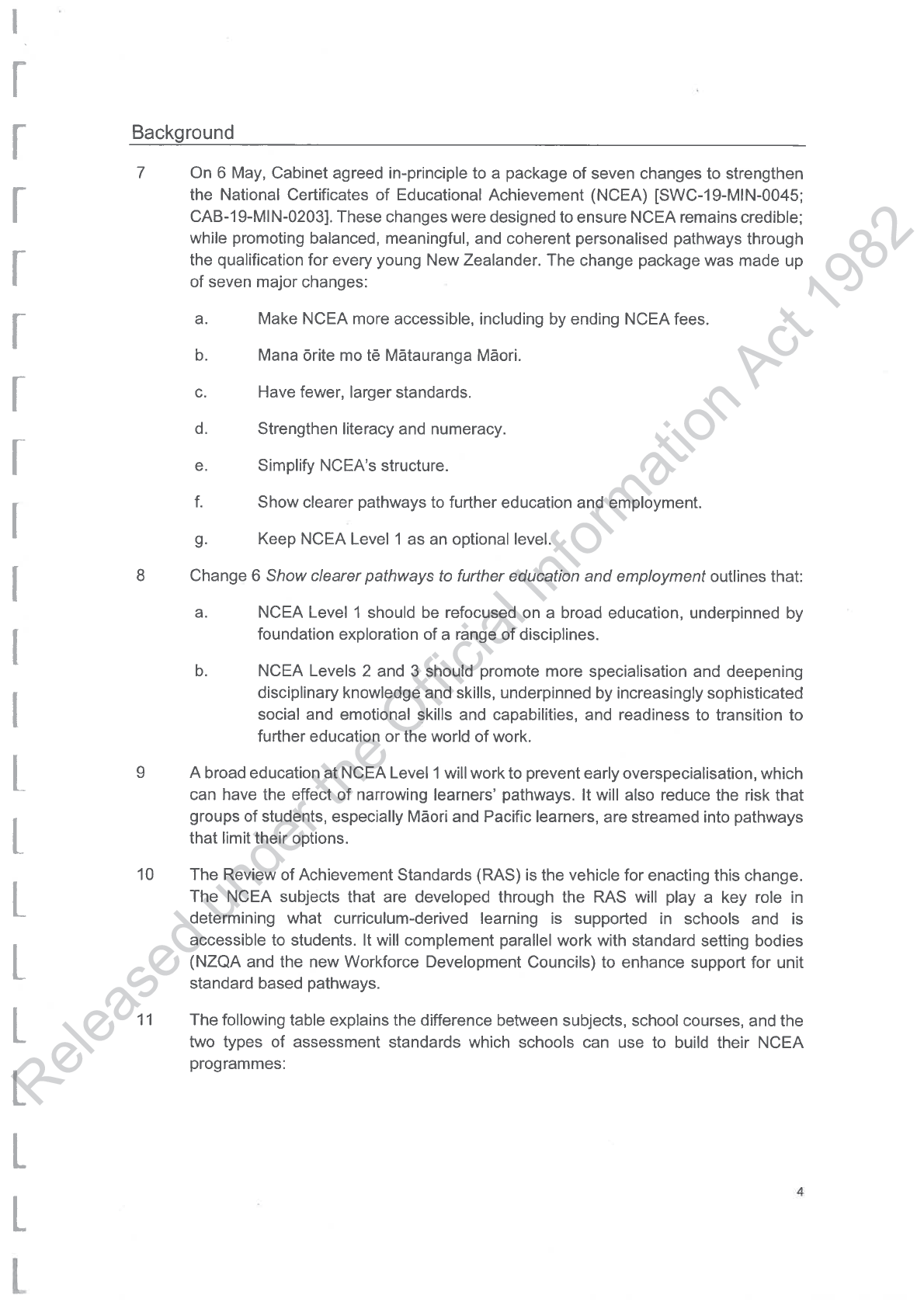



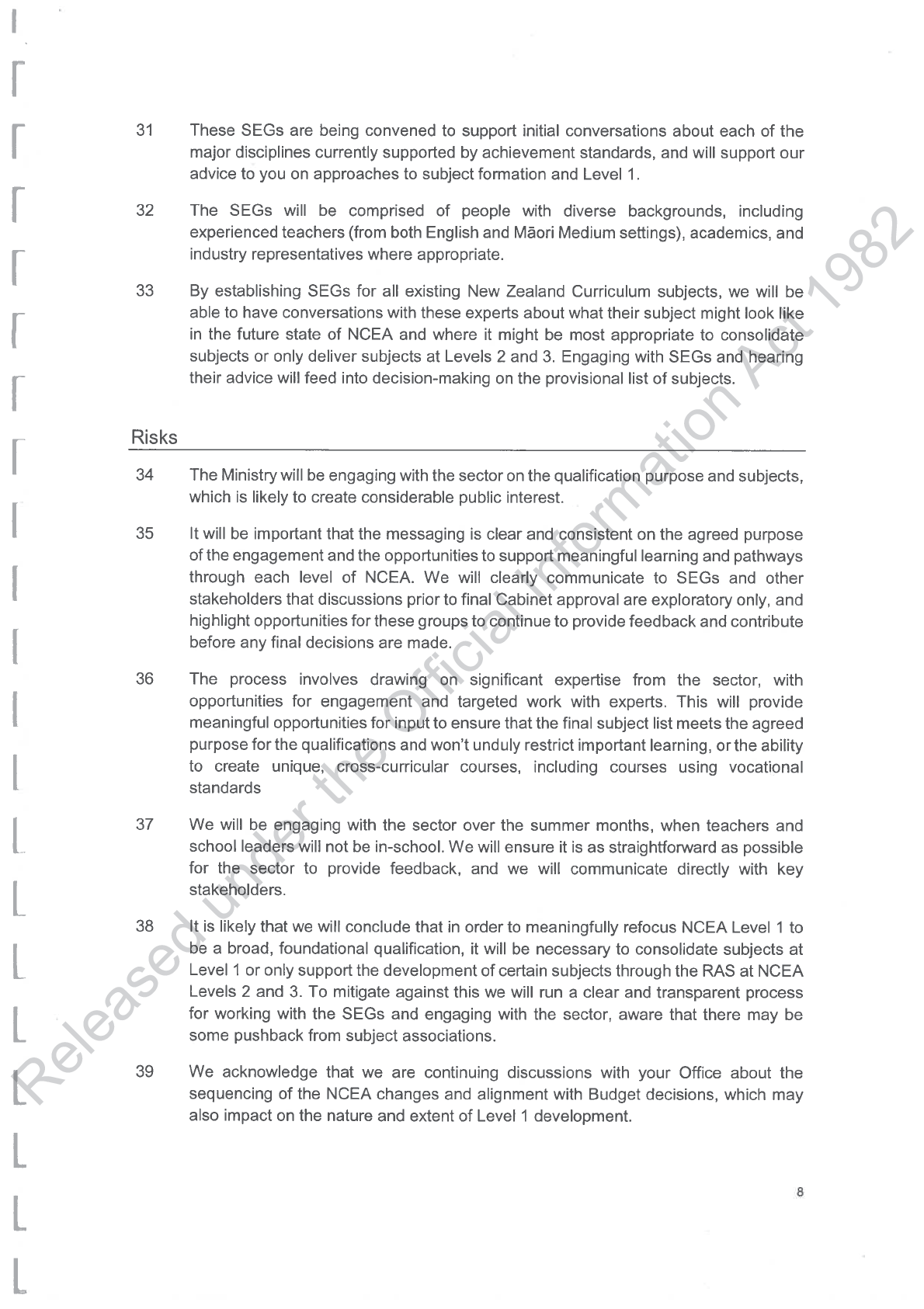
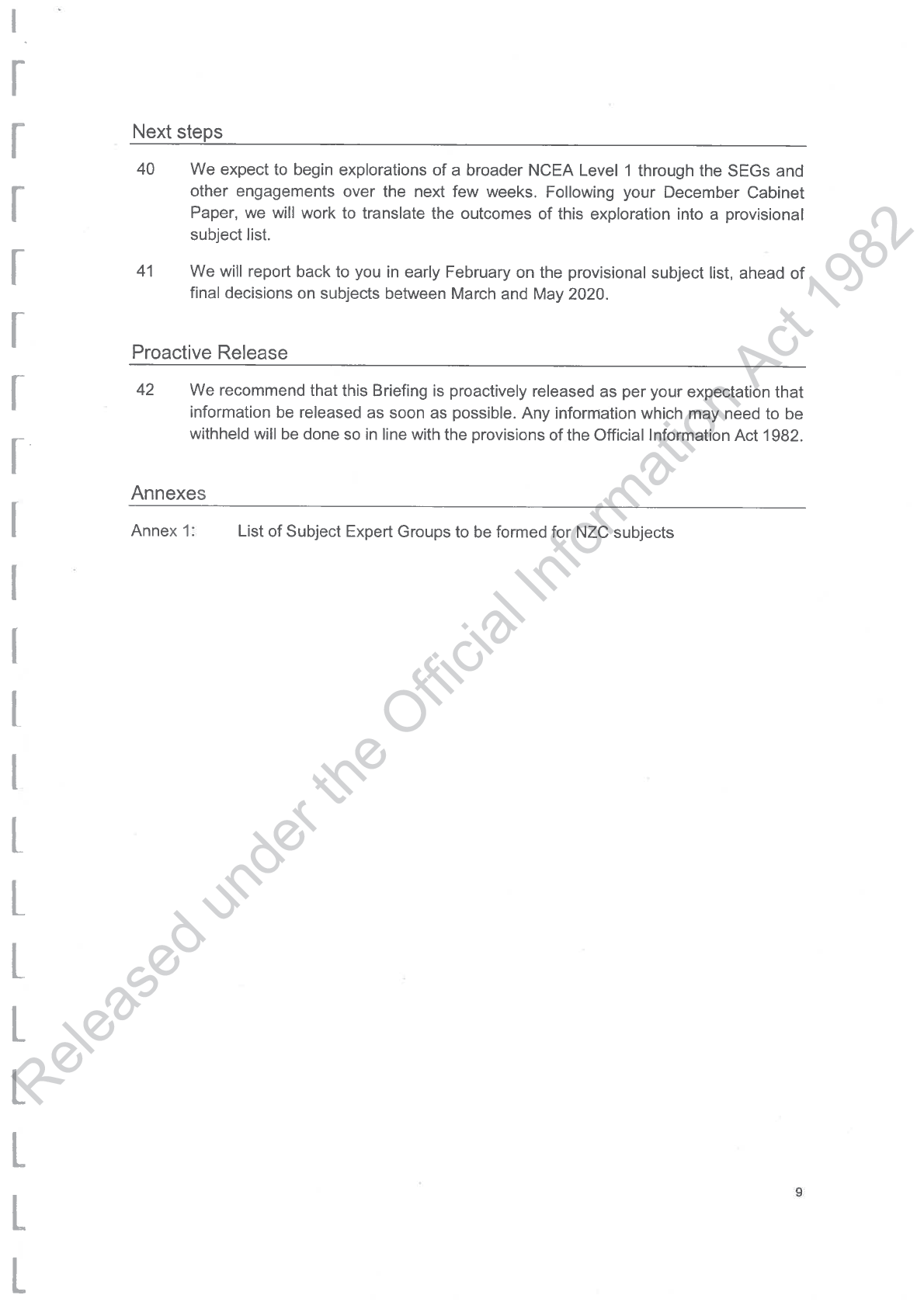
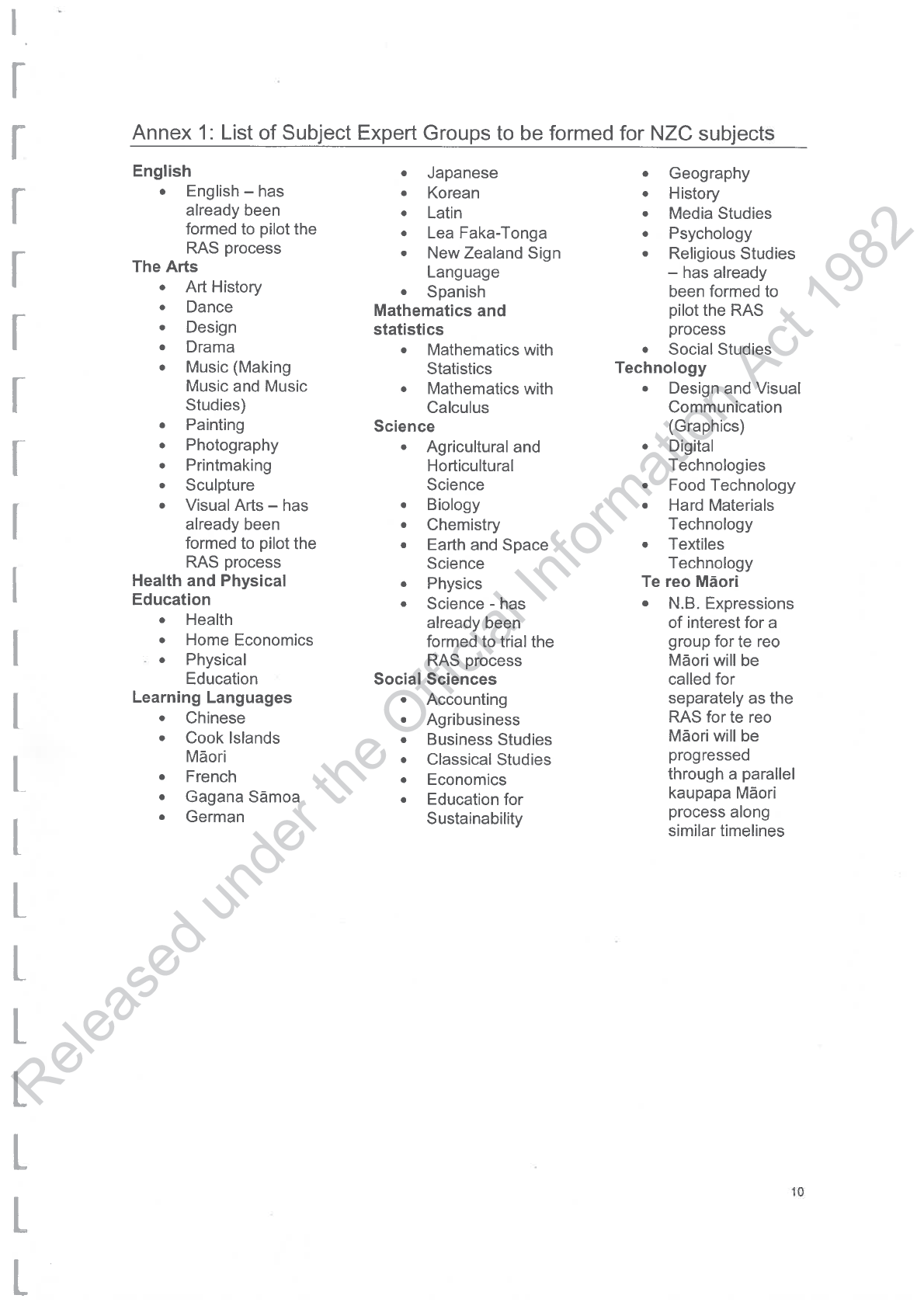

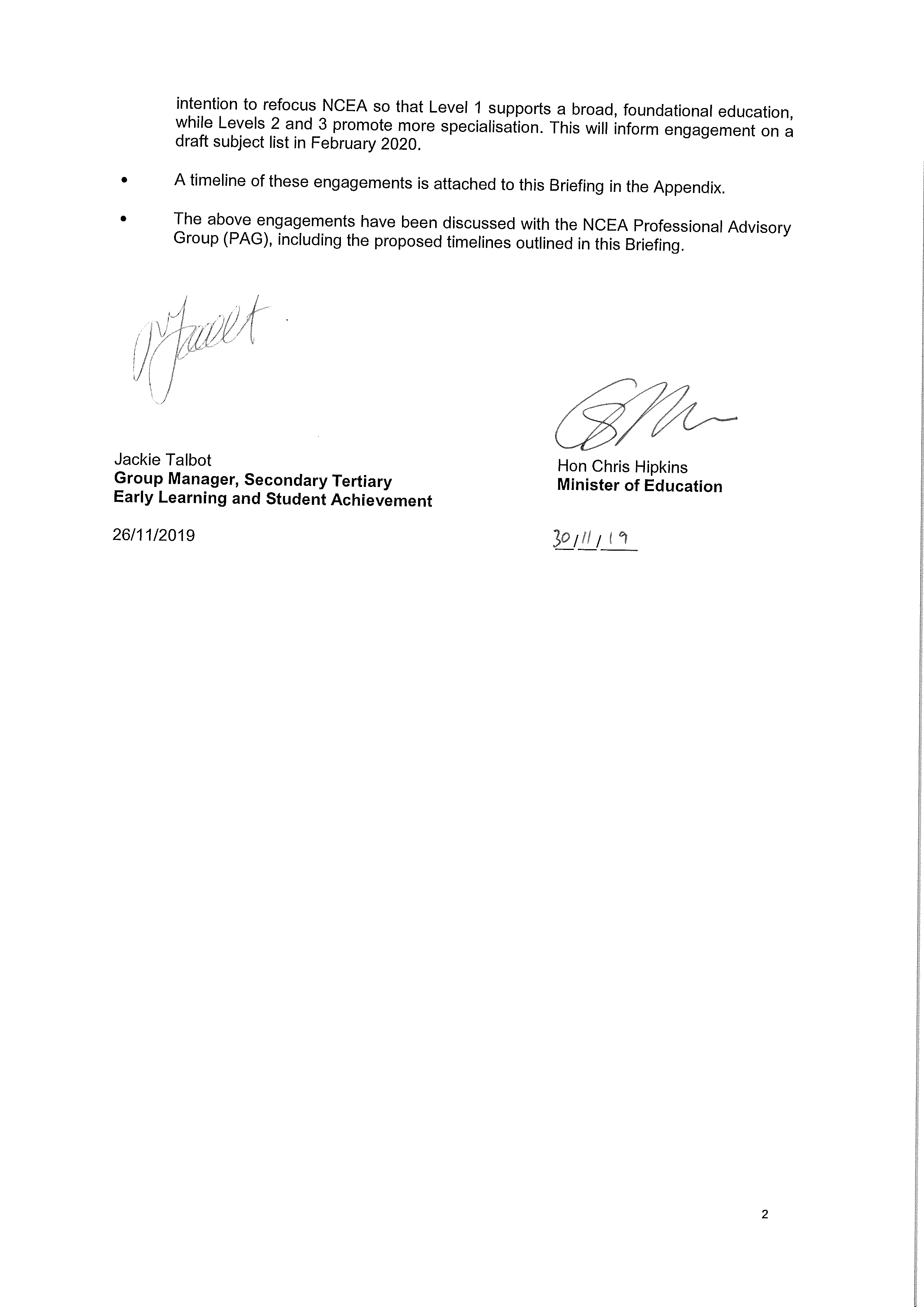
under the Official Information Act 1982
Released

under the Official Information Act 1982
Released
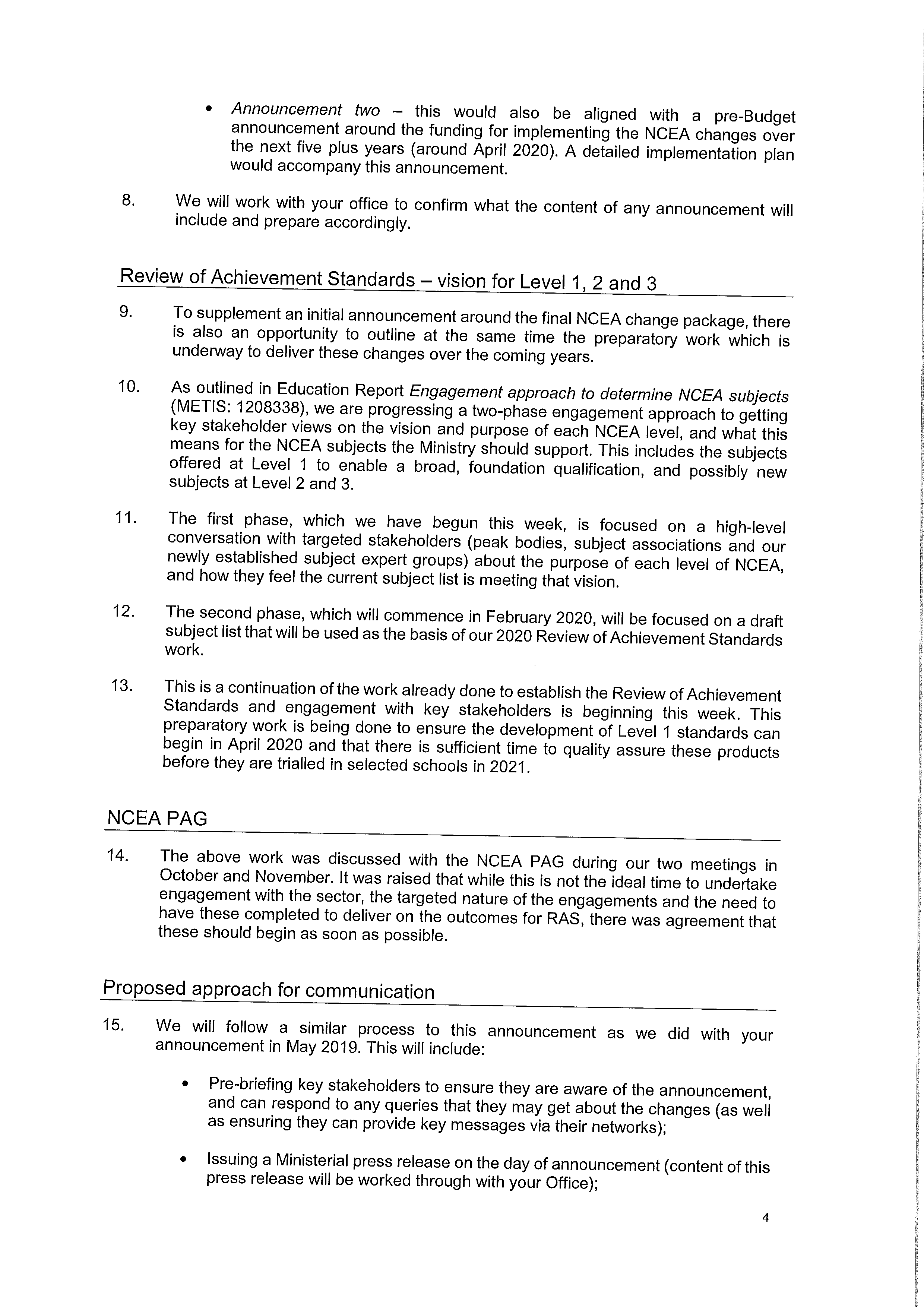
under the Official Information Act 1982
Released

under the Official Information Act 1982
Released
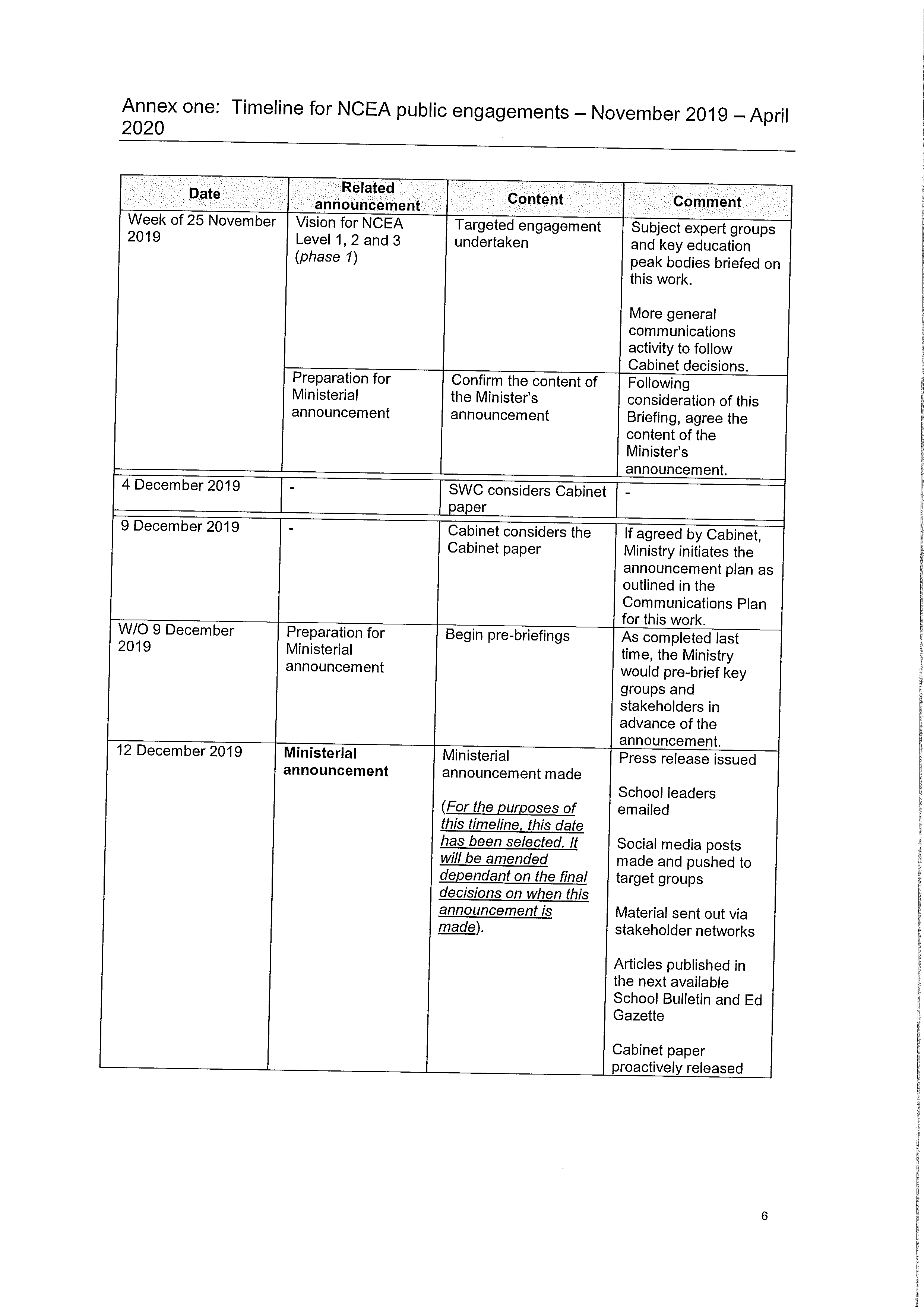
under the Official Information Act 1982
Released
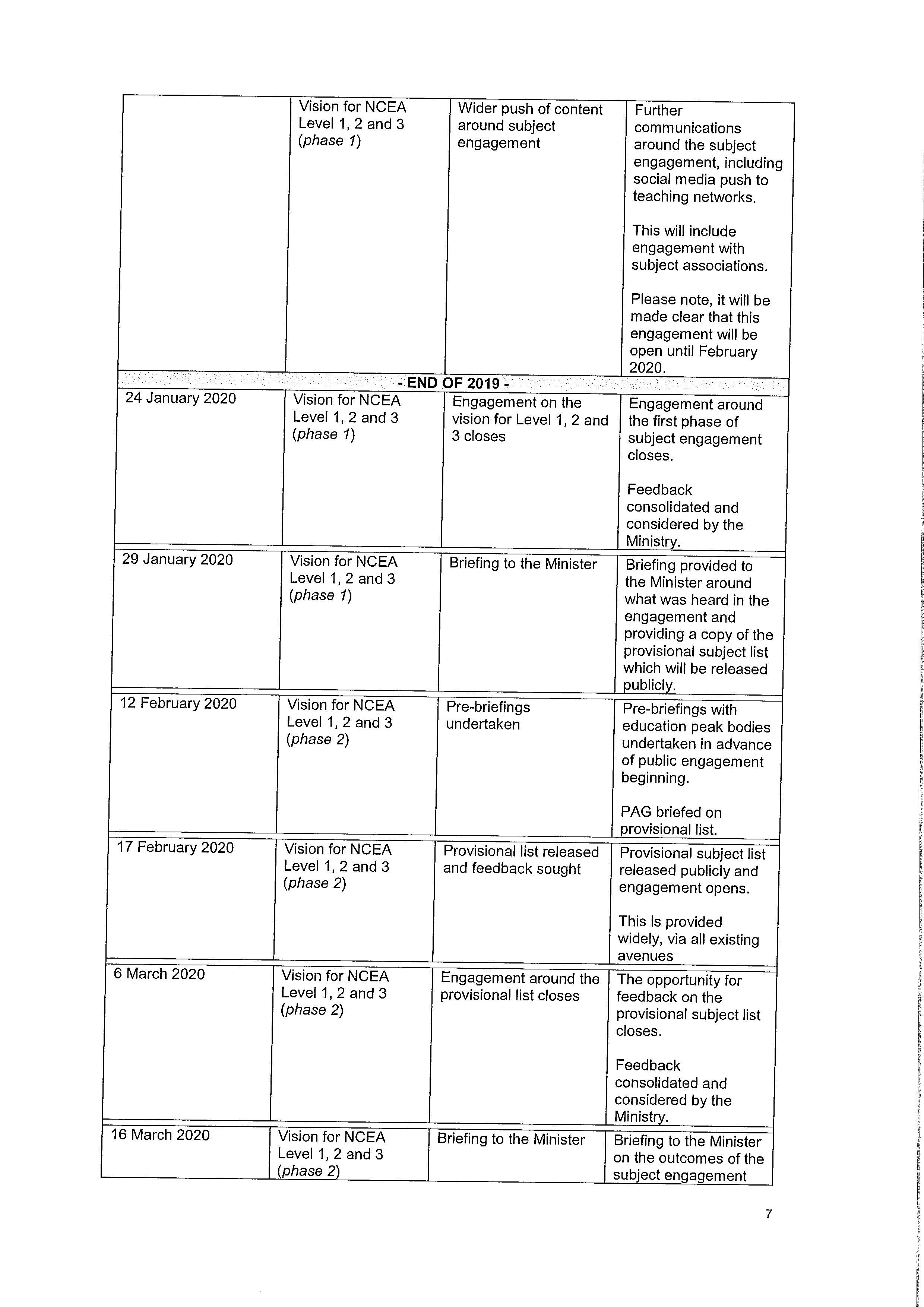
under the Official Information Act 1982
Released
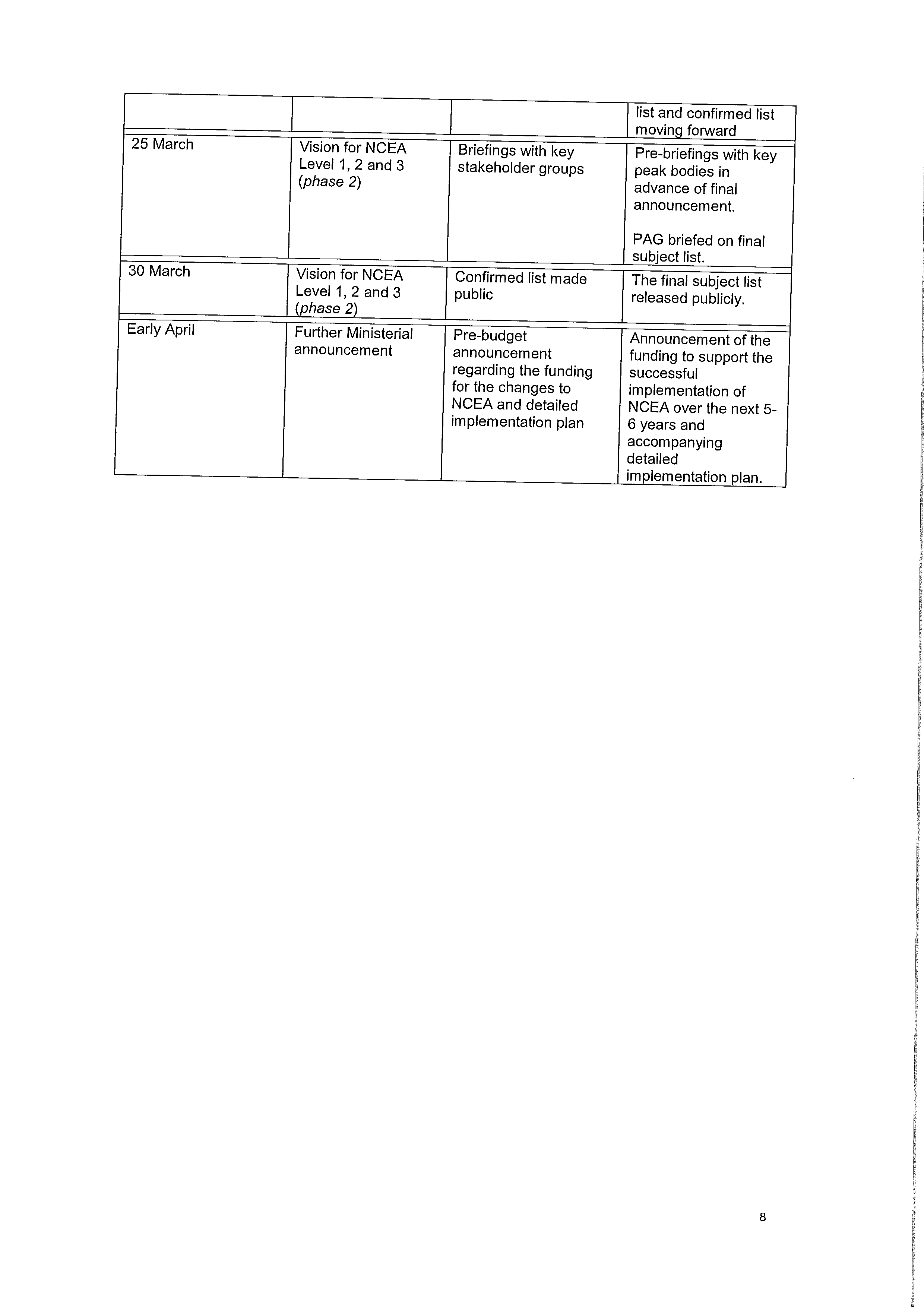
under the Official Information Act 1982
Released
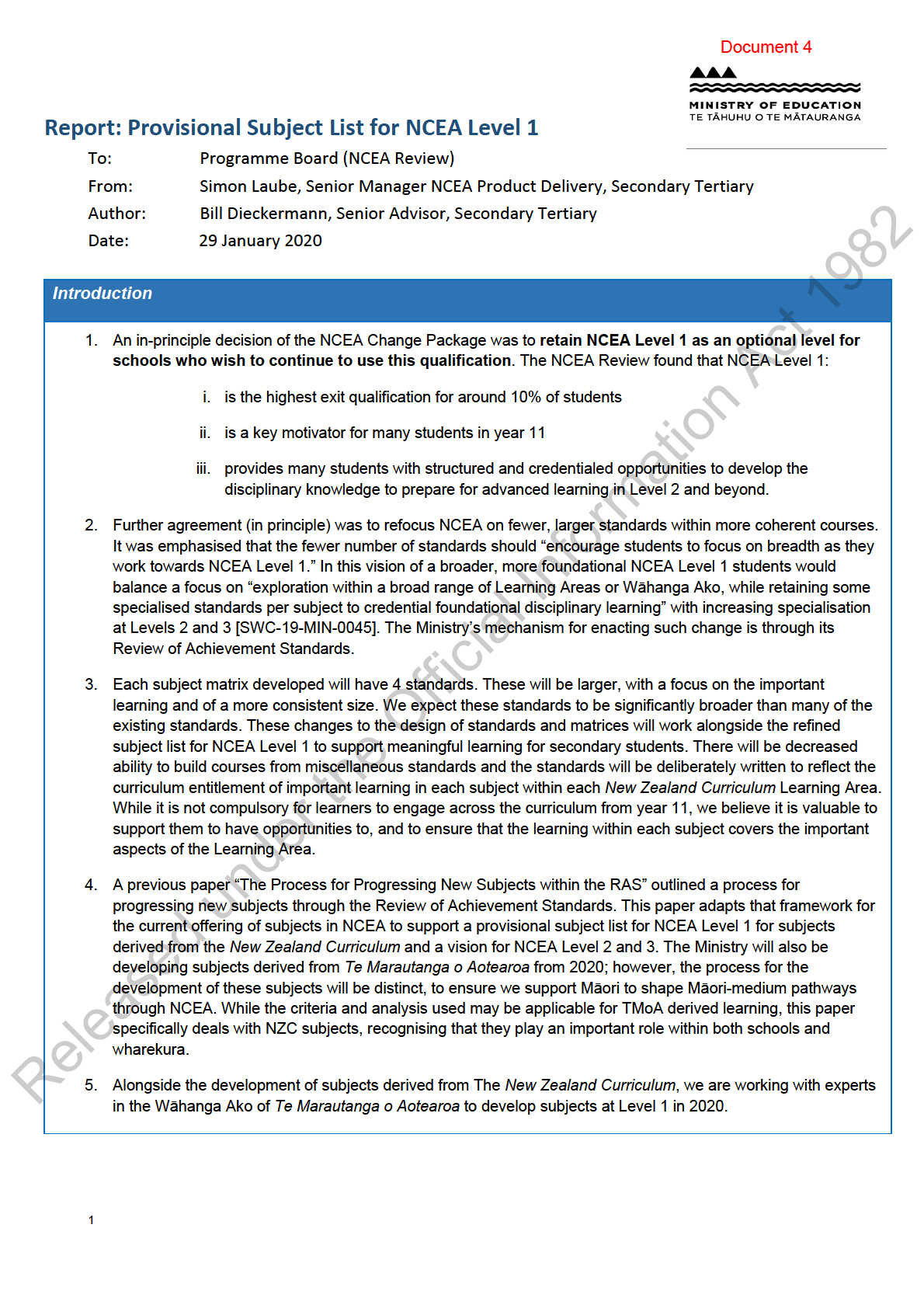

• There are four degrees of support that the Ministry can provide. This ranges from ful support as a
credentialed subject through to being a context within another subject e.g. with support provided to
develop resources for that learning from a discontinued subject within a separate subject (that is aligned
to learning topics or areas of interest) so that learning can continue to be supported through school
courses.
12.
Degree of Descriptions
Reasons in favour
Support
1
Full support for the
Most appropriate for subjects with
subject credentialed at
Level 1
• high usage
• unique curriculum ties and disciplinary knowledge at Level 1 i.e.
subject does not overlap significantly with other subjects
• specific knowledge development is critical for success at Level 2
and beyond
• clear pathways
2
Merge or reorganise
Most appropriate for subjects with
subject with another
related subject or
• overlaps in disciplinary knowledge, big ideas and/or synergies at
subjects at Level 1 with
Level 1
full support from Level 2
onwards
• where he use of (previous) subjects by students indicates that the
lea ning pathway may be overlapping at Level 1
• support clearer pathways at Level 2 and/or 3
• strong curriculum ties
• evidence of a need to increase course coherence
3
Support subject as a
Most appropriate for subjects with
context within another
subject or subjects at
• lower usage
under the Official Information Act 1982
Level 1 with greater
support at Level 2 and/or
• little unique disciplinary knowledge at Level 1
3
• weaker curriculum base at Level 1
• major overlap with another subject or subjects
• potential for a course to exist at Level 1 as a cross-curriculum
course or a highly-contextualised course, or as a topic within
another course
Released
4
Discontinue the subject at Most appropriate for subjects with
Level 1 and possibly at
Level 2 or 3 if appropriate
• very low usage
3
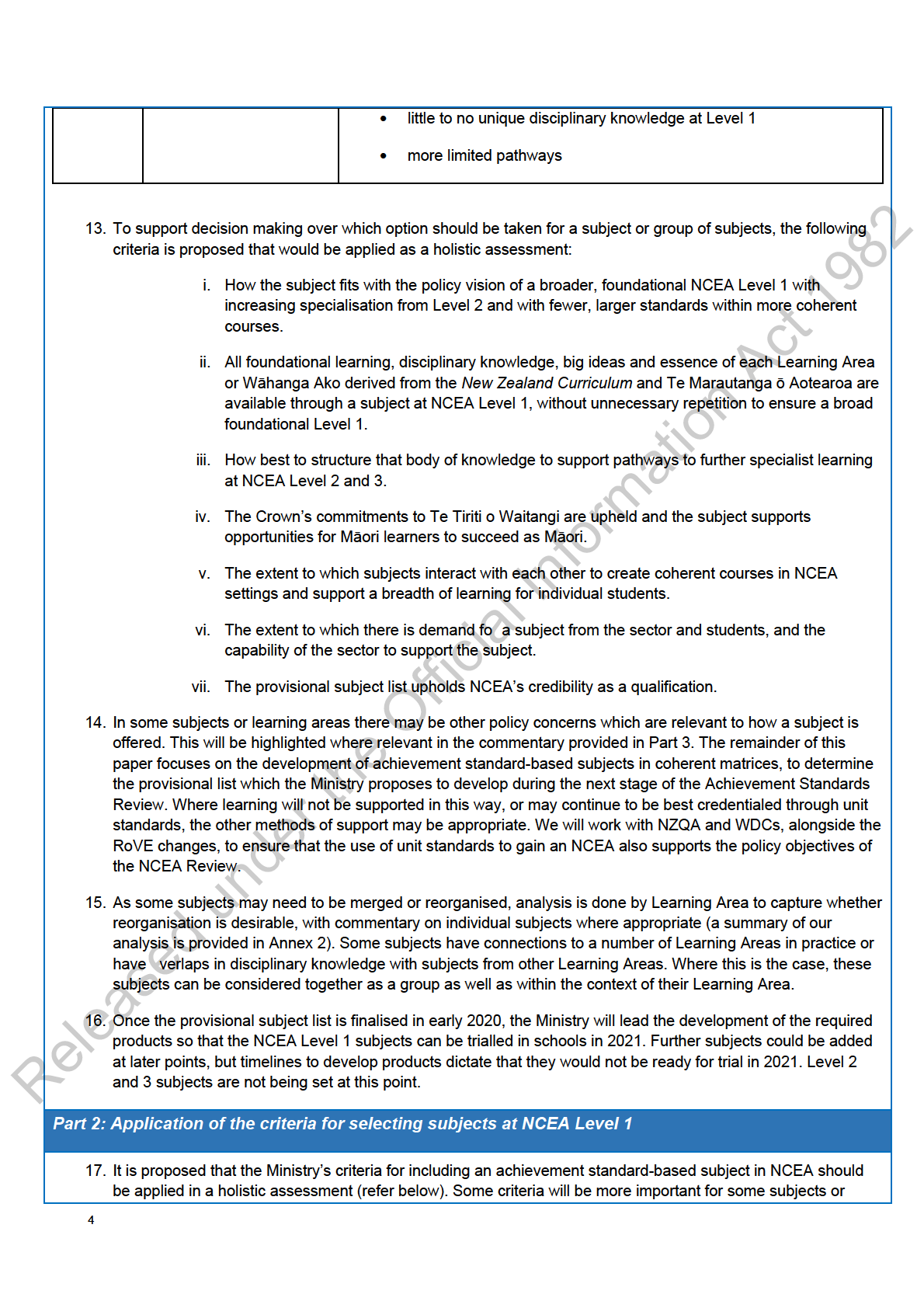
Learning Areas or Wāhanga Ako than others based on the current state of the subject, Learning Area or
Wāhanga Ako and the needs which have been identified through sector engagement and the NCEA Review.
Criterion 1: How the subject fits with the policy vision of a broader, foundational NCEA Level 1 with
increasing specialisation from Level 2.
18. This work focuses on Changes 4
Have fewer larger standards, 6
Show clearer pathways to further education
and employment and 7
Keep NCEA Level 1 as an optional level. Change 6 includes the intention to refocus
NCEA so that Level 1 supports a broad, foundational education, while Levels 2 and 3 promote more
specialisation.
19. These changes were intended to respond to feedback through the NCEA Review about the negative effects of
early specialisation and streaming of young people, particularly on Māori and Pacific learne s and how early
specialisation can restrict students’ education pathways. In the current structure of NCEA common examples
include schools taking advantage of large subject matrices to create courses which use more internal
assessment for students streamed into “lower band” classes that lack curriculum coherency and do not properly
prepare those students for the next step of learning.
20. Recent school leavers and university submitters to the NCEA Review also noted that early specialisation at
NCEA Level 1 had implications for the pathways of young people as it reduced their exposure to the breadth of
the curriculum. This can reduce the options for young people at NCEA Level 2 and 3 and consequently post-
school pathways. The trade-off of a broader qualification is that some deeper disciplinary knowledge in some
subjects may be lost if they are merged with other subjects or delayed until later, making it more difficult for
students to succeed later. To respond to this situation, the Ministry’s decisions on subject choices available at
Level 1 should consider the impact on student pathways through later levels.
21. The changes were also intended to encourage more students to have external assessment opportunities. Since
2012 there has been a steady decline in the percentage of external assessed credits attained by students.
Feedback through the NCEA Review indicated that there were concerns that this trend was reducing the
credibility of the qualification. The subject list itself wil not directly influence the balance between external and
internal assessment, so this issue wil be addressed separately.
22. Note that this vision of a broader NCEA intersects with the Change Package’s focus on equity, in particular for
the most vulnerable learners. For example, for students with learning support needs or disabilities a broader
more foundational NCEA Level 1 should support those students to access a greater range of the curriculum at
Levels 5 and 6. It is, however, important that matters of equity are considered when determining the provisional
subject list, particularly where there may be few subjects in a learning area. Where there are possible pitfalls
from an equity perspective further work will be required to ensure that the outcome has a balance of subjects
that actually work for vulnerable learners and accessible to all, with further changes to be considered where
necessary.
under the Official Information Act 1982
23. Applying Criterion 1 necessarily means reducing the number of subjects within each Learning Area where
possible to encourage programmes of learning for individual students which cover as much of the
New Zealand
Curriculum as possible. However, this wil have to be balanced against ensuring that every subject offered
within NCEA as a whole has a coherent pathway and that important foundational learning at Level 1 is available.
Criterion 2: Al foundational learning derived from the New Zealand Curriculum and Te Marautanga o
Aotearoa at Level 6 is available
24. Al subjects offered as part of NCEA via achievement standards must be derived from the
New Zealand
Released
Curriculum or
Te Marautanga o Aotearoa. Most subjects wil be a subset of a Learning Area at a given
curriculum level, while a few wil cover an entire Learning Area (such as English and Te Reo Pākehā) or draw
from multiple Learning Areas explicitly or implicitly (such as Media Studies or Agribusiness).
5
25. The
New Zealand Curriculum and
Te Marautanga o Aotearoa makes all Learning Areas compulsory up to Level
5. At Level 6, which is where most learners engage with a full NCEA Level 1 programme, there are no
compulsory Learning Areas which in practice can create a sharp change in the programmes of learning for
many students at Year 11. This is particularly important for students whose understanding is not yet at Level 5
of the Curriculum in some Learning Areas; oftentimes these students do not have many more opportunities to
gain the foundational learning at Level 5 as their NCEA Level 1 courses do not give those opportunities. In
making NCEA Level 1 a broader, more foundational qualification we essentially consider Levels 5 and 6 of the
New Zealand Curriculum and
Te Marautanga o Aotearoa holistically to smooth this transition and increase the
opportunities for students to gain the foundational knowledge at Levels 5 and 6.
26. The alignment process during the 2012 review of NCEA aimed to align the then achievement standards with the
Achievement Objectives of the
New Zealand Curriculum. The alignment process also converted a large number
of unit standards to achievement standards. Although this process means that we know that the current offering
of subjects have some alignment to the
New Zealand Curriculum, it also led to the current structure of NCEA
with too many standards within some subject matrices which as a consequence led to the creation of courses
which did not cover all the foundational learning within a subject. This is a particular y noticeable problem in
subjects where there were many unit standards converted into achievement sta dards. Furthermore, in some
Learning Areas, particularly Science, the large number of achievement standards and subjects mean that
schools often mix and match standards to create courses which do not necessarily ensure that students have
learnt the most significant foundational knowledge in the Learning Area.
27. The Curriculum, Progress and Achievement (CPA) work programme is working towards creating a framework
for ensuring that the education sector’s understanding of the
New Zealand Curriculum is up-to-date. Recent
work in the CPA work programme has led to the clarification of Learning Area Essence Statements which
outline the essential learning at curriculum levels 6-8. The essence statements are broad-stroked statements
which describe the competencies and big ideas which students in senior secondary education should be
engaging with. The starting point for determining the provisional subject list is to ensure that the offering of
subjects for each Learning Area align to and cover the learning in the essence statements.
28. For some subjects currently available there is an overlap in the curriculum-derived learning credentialed through
that subject with other subjects. In some instances the overlap at the curriculum level may be very different in
the practice of each subject, in which case it is more appropriate to support subjects separately. However,
where the overlap is significant there may be a case for merging or reorganising the subjects. At the extreme,
the overlap between a narrow subject and a broad subject may mean that the narrower subject is more
appropriately catered for at NCEA Level 1 as a supported context.
29. Applying this criterion can have a range of impacts. In some Learning Areas, this wil mean little in terms of the
available subjects. In ot ers, this may mean a comprehensive reorganisation of how the Learning Area is
organised to refocus the available subjects on the most important foundational learning.
Criterion 3: Supporting pathways
under the Official Information Act 1982
30. As part of enacting Change 6, each subject offered in NCEA wil need to show a clear pathway to further
education and training, and the labour market. Subjects also need to align to progress against the curriculum
and internal pathways through NCEA to give students opportunities to develop necessary disciplinary
knowledge, skil s and capabilities to progress to the next level.
31. Disciplinary knowledge or skil s required for a pathway can be determined by working backwards from formal or
informal pre-requisites for tertiary education, further training or the world of work. This can be seen most clearly
in the pre-requisites for some professional degree programmes such as medicine and engineering where there
Released
is an expectation of prior learning at secondary of particular aspects of science and mathematics.
32. Conversely, where a subject does not prepare students for the next step of the pathway, or is not necessary for
success in the next stage, then questions need to be asked as to whether that subject is necessary at that level.
This concern is more important at NCEA Level 1 where a broader foundational qualification is desired; if
6
important disciplinary knowledge can easily be and often is picked up at NCEA Level 2 then our assessment is
that offering that subject at Level 1 is a lower priority.
33. However, there stil needs to be a clear pathway for students who may want to pick up a subject at Level 2.
Some Level 2 subjects build on Level 1 conceptual understandings of content and contexts which need to be
present at Level 1 in some form. This can be done by incorporating contexts from Level 2 or 3 subjects into
exemplars for Level 1 subjects which prepare students for those subjects if deemed essential. For example
currently Agribusiness only exists at Level 2 and 3; students can be prepared for Level 2 Agribusiness through
the use of agricultural contexts in Business Studies or commercial contexts in Agricultural and Horticultural
Science.
34. Usage data on current NCEA subjects can show patterns which reveal the relative importance of different levels
of NCEA in a subject’s pathway. For example, if a subject has lower usage at Level 1 compared to Level 2 or
Level 3, or has a significant number of new students at Level 2 and 3 then that may be evidence that schools
currently do not see the Level 1 matrix as necessary for success in the subject. NZQA has produced usage data
which shows the relationship between two or more subjects which can reveal which subjects have significant
overlap in students.
35. Some level of specialisation is still required to support students’ transition to fu ther education and training. This
is most appropriate at Level 2 and 3 where pathways for students become more concrete and clear and
students are making more deliberate and informed choices about their future. By Level 3, a student is likely
making a conscious decision to remain at school to follow a particular pathway; increased specialisation is not
only appropriate but likely desirable for students with a particular pathway in mind. However, broad generalist
subjects should stil exist for students wishing to pursue broad pathways such as a generalist university degree.
36. Supporting pathways also means ensuring that subjects can lead to University study where relevant. This
means that University Entrance is also a policy concern at Levels 2 and 3. University Entrance is set by NZQA
in consultation with each university and Universities New Zealand and is outside the scope of the NCEA
Review. Under the current model of University Entrance students need to obtain credits from discrete NCEA
Level 3 subjects which means schools are more likely to offer courses built upon standard subject matrices.
However, changes to University Entrance can have an impact on school practices around course building so it
is important that we work alongside Universities New Zealand to understand the possibilities of change to
University Entrance how they follow on from school pathways. This is a concern for the provisional Level 1
subject list as considerations over the Level 2 and 3 subject list are salient to decision making at Level 1.
37. Although provisional subject lists for Levels 2 and 3 do not need to be decided yet, they are still broadly relevant
when considering the next steps from the provisional Level 1 subject list. This is most important when looking at
subjects which wil see the most change at Level 1 as this wil give some certainty for the sector on our vision for
NCEA.
38. There has also been significant work progressing new subjects particularly in the vocational space and new
under the Official Information Act 1982
mātauranga Māori subjects aligned to the
New Zealand Curriculum. Although decisions over what subjects may
be introduced have not been made yet, possible new subjects should be considered when looking at pathways
from Level 1 and the overal structure of the provisional subject list at Level 1.
39. Applying this criterion to the provisional subject list wil mean that when considering the status of a subject at
NCEA Level 1, we wil need to consider what Level 2 and 3 subjects it may lead to and how to ensure that
students are well supported along that pathway. We also need to consider how changes to Level 1 may require
changes to be made at Levels 2 and 3 in both their subject lists and the content included in those subjects. This
will look like considering questions such as:
Released
• How does this change impact how Level 2 or 3 may be offered in this subject?
• What subjects at Levels 2 or 3 could this lead to?
7
• What pathways out of school need to be supported and what subjects should exist at Levels 2 and 3,
and consequently Level 1?
Criterion 4: Ensuring coherence and pathways in local curricula
40. To support schools to deliver coherent NCEA Level 1 courses and programmes, the structure of the new
standards and the provisional subject list need to encourage coherent course design. One of the big messages
that we heard during the NCEA Review was that many felt that there was a need to increase the level of
coherence in NCEA. Reasons given included concerns that some schools constructed courses which
maximised internal assessment and pass rates at the expense of coherent disciplinary teaching and learning, or
picking and choosing standards to create courses with little thought as to how the course supported students
overall. These courses disproportionately impacted upon Māori and Pacific learners. Although the new
standardised matrices makes this less likely, where schools create bespoke courses across subject matrices to
meet a local curriculum need low quality course design can stil occur.
41. To understand the probability that an additional subject may increase the risk of incoherent courses we can
examine current practices in NCEA by looking at a representative sample of school and wharekura course
structures. In particular we can examine where schools and wharekura offer courses which are variations of the
same subject in order to stream students or courses which draw from multiple subject matrices. This can identify
how schools and wharekura are likely to react to any changes to NCEA subject offerings and if there are any
likely unintended consequences.
42. The provisional subject list proposed for the
New Zealand Curriculum contains fewer subjects than is currently
available at NCEA Level 1. Some schools may wish to continue to offer learning drawn from subjects which are
currently available through creating new cross-curricular courses at Level 1. If done poorly, these may lack
coherence. This creates a potential trade-off between retaining a subject to ensure it has a coherent matrix at
the expense of the goal of a broad, foundational NCEA Level 1, especially if the subject is narrow in scope with
regards to its curriculum base. In this case it may be appropriate to consider how schools can be supported to
create coherent cross-curricular courses through supporting resources which use similar contexts across
multiple subjects.
43. Course offerings at years 9 and 10 and how they relate to NCEA subjects can indicate how schools and
wharekura implement the curriculum entitlement through course and programme design. While some of these
subjects may not be included in the proposed subject list at Level 1, schools may wish to continue offering the
precursor courses at a junior level. Where this is an issue, to ensure coherent pathways into NCEA Level 1, we
should consider how these subjects can be supported as contexts at Level 1 so that schools are stil supporting
students to engage with important curriculum learning from years 9 to 13.
44. We also know that many schools and wharekura offer NCEA achievement standards or full subjects to students
in years 9 and 10. It is important that this exposure to NCEA supports learners engaging with the full extent of
the curriculum and does not contribute to their learning being unnecessarily narrowed.
under the Official Information Act 1982
45. Although current school and wharekura practices should be considered when determining subjects for NCEA,
they should not be seen as overall justifications, particularly where the aims of the NCEA Review are to
encourage changing those practices.
Criterion 5: Demand and Sector Capability
46. For subjects to be properly taught, there needs to be a workforce that can deliver them and can create, mark
and moderate assessments both internally and externally. This is most pertinent for learning areas where there
Released
is significant change to how subjects are structured. If two subjects are proposed to be merged or reorganised
at Level 1 it is important to ensure that the current workforce can deliver the new subject, particularly where
subjects draw from multiple learning areas. Concerns with the workforce’s capability to deliver a proposed
subject can be mitigated through ensuring sufficient support to the workforce such as resources and PLD, and
8
working with Initial Teacher Educators (ITEs) to ensure that initial and returning teacher training supports new
teachers to use the new standards and subjects.
47. It may also be a relevant concern that merging or reorganising subjects may lead to subjects which some
schools believe they wil not be able to deliver. For example, if specialist equipment is often used in one subject
schools which do not offer that subject currently may not believe they wil be able to continue to offer the
merged subject. Feeding in these concerns into the analysis behind the provisional subject list wil reduce the
probability that issues arise.
48. Subject demand and usage is also an important factor to consider. NZQA usage data shows the demand for
subjects relative to other subjects. Subjects with high usage, particularly compared to usage of other subjects
within the same Learning Area, are better off supported than not as it is clear that schools want to teach that
subject and there is student demand. Removing an in demand subject can create unintended consequences
including schools finding other ways to offer the subject. Subject demand also shows us trends in usage which
can be indicative of the overall health of the subject. Usage trends can inform us whether a subject can
realistically stand on its own or whether it is better to treat the subject as a context within another subject.
Criterion 6: Te Tiriti o Waitangi and Mana ōrite mō te mātauranga Māori
49. This work also aligns with Change 2 - Mana ōrite mō te mātauranga Māori as the implementation of this change
wil involve the creation of new mātauranga Māori subjects in
New Zealand Curriculum settings, meeting the
Crown’s commitments to Te Tiriti o Waitangi. This paper includes the addition of one more of these subjects,
Māori Performing Arts, which is likely to be created as part of the review.
50. The Crown and Ministry’s obligations under Te Tiriti o Waitangi are of paramount importance when considering
inclusion of subjects within NCEA.
51. While the Ministry’s obligations under Te Tiriti should be considered holistically, relevant considerations wil
include:
• The perspectives of Māori, including iwi and relevant kaitiaki, on whether the Ministry should support a
subject
• That the Ministry should wherever possible enable and support Māori to preserve and revitalise
mātauranga Māori and te reo Māori
• That kaitiakitanga may apply to certain bodies of mātauranga Māori, and that subjects or standards
which are deve oped wil need to appropriately respect that, balancing access against cultural protection
• That subjects grounded in te ao Māori ought have equal mana with subjects which reflect non-
indigenous paradigms or knowledge bases.
under the Official Information Act 1982
52. When considering other criteria, meeting our obligations under Te Tiriti o Waitangi means specifically
conside ing Māori perspectives on the relevant criteria – particularly where subjects are grounded in
mātauranga Māori, or have high uptake by ākonga Māori. For example, where overall uptake of a subject is low
but a high proportion of those students are ākonga Māori, this should be considered in determining whether a
subject continues to receive support.
53. This commitment to Te Tiriti in determining the provisional subject list means ensuring that subjects which are
particularly important to Māori as Māori are available through NCEA. This is not just in terms of cultural value,
but also in terms of the practical outcomes for ākonga Māori in English-medium settings. For example, Māori
Released
uptake of a subject should be considered particularly in a subject with high uptake by Māori. Local school
practices relating to subjects which disproportionately impact Māori should also be considered. This includes
subjects which are particularly important to many ākonga Māori as well as those subjects which ākonga are
disproportionately channelled into at the expense of relevant education, employment, or cultural pathways.
9
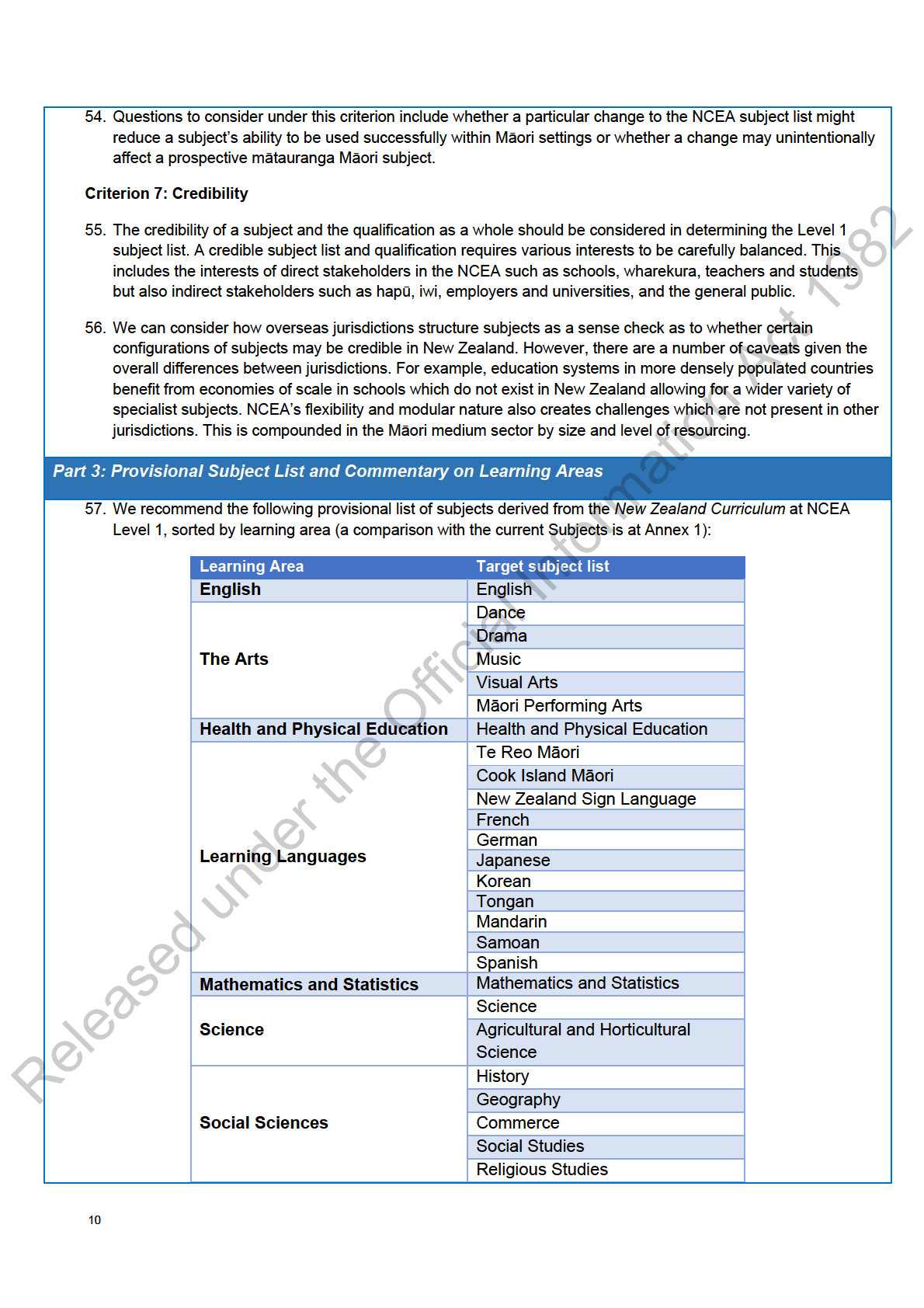

65. The four subjects we wil keep in the Arts align with the four disciplines in the
New Zealand Curriculum.
Although all four Arts subjects are focussed around the same four interrelated strands, the disciplines are
different enough in terms of the disciplinary knowledge and foundational knowledge in each subject. Much of the
Learning Area focuses on acquiring technical skil s within the discipline which need to be acquired before
progressing to the next level. A reorganisation of the Learning Area may reduce the ability for students to
progress through the pathways associated with the Arts Learning Area.
66. Art History is a particularly narrow subject with weak links to the New Zealand Curriculum. Continuing support
for this subject would not align with the vision of a broader NCEA Level 1. The key foundational learning with n
this subject is generally covered by those in Visual Art as well as a range of Social Sciences. It can stil be
taught as part of a broader Level 1 programme of learning through being a specific context within one of those
subjects and should be supported as such. Currently, many students successfully engage with this learning
from Levels 2 or 3 and so Level 1 specialisation is unlikely necessary.
67. Māori Performing Arts is likely to be added to NCEA as part of the Review of Achievement Standards as a
subject which supports Change 2
mana ōrite mō te mātauranga Māori. The assessment of Māori Performing
Arts is not easily assessed through the other four Arts subjects due to the nature of the subject nor should it be.
Health and Physical Education
68. Currently the Health and Physical Education Learning Area contains three subjects: Health, Physical Education
and Home Economics. We recommend reorganising the HPE Learning Area as one subject at Level 1: Health
and Physical Education (HPE) with Health and Physical Education fully supported as individual subjects from
Level 2 onwards. Home Economics is currently a subject within this learning area which contains some
important
New Zealand Curriculum-derived learning, but with variable practice and much overlap with some
Technology courses. The important Health and Physical Education curriculum content from Home Economics
would be captured in the HPE subject, while a new Technology subject, Food Science wil capture much of the
teaching and learning currently included in Home Economics courses. Food Science is discussed below as part
of the Technology Learning Area.
69. Health and Physical Education are curr ntly closely related subjects at Level 1. Based on self-reported data by
schools to the Ministry, about half of year 9 and 10 students undertake combined Health and Physical Education
classes. Analysis of usage data by NZQA of the 2016 Year 11 cohort found that 34% of students taking health
at Level 1 also took Physical Education indicating close relationships in terms of pathways and curriculum
content. Both subjects have strong focuses on wellbeing frameworks, personal growth and development, and
societal attitudes. Merging at Level 1 wil ensure students with a strong health and PE focus currently to have a
broader education at Level 1.
70. At Level 1 both subjects can be seen has having narrow focuses and would be better served as part of a larger
subject for the purposes of meeting the vision of a broader foundational NCEA. Health standards at Level 1
currently focus on a number of discrete health issues such as drug use and sexual health but there is a large
under the Official Information Act 1982
degree in similarity in the big ideas and significant learning in each standard. This curriculum derived learning
overlaps significantly with the curriculum content in the Physical Education matrix apart from the standards
focused on performance in physical activity. Combining the two subjects at Level 1 would allow for a broader
coverage of the Health and Physical Education learning area for both students who want to follow a health
pathway and those who want to follow a Physical Education pathway.
71. We currently assess the principal drawback of a combined Health and Physical Education subject is that
students with a particular interest in the study of health who are not physically fit or particularly skil ed at sport
may be discouraged from choosing the subject (and vice versa, to a lesser degree). This might mean an even
Released
more significant impact for disabled students and students with learning support needs, potentially
disadvantaging the pathways of individual students. At this point we consider these potential negative impacts
can be mitigated through the design of the standards and matrix (so as to allow for course designs that support
12
these students), ensuring that the subject reflects the broader content coverage and intent of the learning area
without an unduly narrow focus.
72. There is also an issue with workforce capabilities. Although many PE teachers have Health backgrounds, that is
not necessarily true of all health teachers, particularly those with a stronger interest in the social science
elements of health studies, or those who also teach Home Economics. A merger may cause some resourcing
issues at the local level, but wil likely be minor given the current workforce.
73. Research conducted by the Ministry looked at the pathways of different clusters of students within the 2010
school leaver cohort and their life outcomes based on IDI data. One cluster of students with a strong focus on
PE and Health was found to have poor outcomes. This cluster included a large number of students from at-risk
backgrounds, particularly at-risk Māori and Pacific boys. We consider that there are potential impacts to work
through further in this regard that potentially could be supported through the design of the standards and matrix
(again to ensure the right support for these students is in place).
74. A combined subject would support current health and physical education pathways due to large overlaps in
those pathways currently. Keeping the subjects separate at Levels 2 and 3 is preferable as overlaps are less
significant at a higher level.
Learning languages and Te Reo Māori
75. Currently the Learning Languages learning area has 12 subjects which can be divided into three categories:
official languages, international languages, and Latin. We recommend the retention of all subjects except Latin.
Official Languages
76. This group currently covers three subjects: Te Reo Māori New Zealand Sign Language and Cook Islands
Māori. These subjects must be retained as the official languages of New Zealand and the Cook Islands.
77. Two other Realm countries do not currently have their official languages supported through achievement
standards; Niue (Vagahau Niue) and Tokelau (Gagana Tokelau). Niue uses NCEA and Vagahau Niue is
supported by NZQA through unit standards. Tokelau is considering adopting NCEA as the national qualification
system but Gagana Tokelau is not supported through any assessment standards currently.
78. There would be significant challenges in developing, maintaining and using achievement standards for these
languages as there is limited teacher, examiner, and moderation expertise and capability. Part of our ongoing
programme involves working with the sector, the Ministry of Education, and wider government to determine
whether it is appropriate to develop achievement standard subjects for these languages. NZQA wil provide
insight into the feasibility of developing and assessing these subjects. Doing so would require significant
investment and support.
79. These subjects a e not included in the provisional subject list as we wil spend this year determining whether
under the Official Information Act 1982
and how to support them through NCEA. Building the required support wil likely be a phased process over a
few yea s, but is able to be done out of sequence with other languages. As languages will likely share a
common assessment matrix, a delayed schedule is possible, and the development of these languages into
achievement standard subjects could begin as soon as 2021.
80. Te Reo Māori is already treated differently from the other languages and has its own curriculum support
documents. In the
New Zealand Curriculum it does not have its own Learning Area, but we recognise that it is
distinct by separating it from other languages on TKI currently.
Released
International Languages
13
81. This group includes French, German, Japanese, Korean, Tongan, Mandarin Chinese, Samoan and Spanish.
These languages are offered for a variety of reasons including being major heritage languages of
New Zealand’s immigrant communities or the languages of major trading partners. Although some of these
languages have small class numbers, decision making over which languages should be offered should be
subject to a further policy review as there are a number of complex factors for each language which need to be
considered individually.
82. There are also historical but currently registered achievement standards for Bahasa Indonesia, however these
do not receive active support from the Ministry of Education or NZQA and have no recent usage. Bahasa
Indonesia is not included in subject lists and does not receive a timetabled examination so is not considered a
current subject. With no clear evidence for demand or sector capability to deliver, we wil not support Bahasa
Indonesia as a subject. If demand and ability to deliver are proven, we could develop this subject at a later date.
83. International Language standards are written primarily for second language learners but heritage language
learners and native speakers often dominate in some subjects. For example, NZQA usage data shows that
Korean and Chinese (Mandarin) have a high proportion of students taking NCEA Level 3 standards without
previously taking the language which implies high usage by international fee paying students and other native
speakers to gain relatively ‘easy’ credits. However, the limited resources and numbers in the languages means
it is not practical to create dual sets of standards for native speakers and second language learners. There
would also be issues in determining which students are allowed to sit which standards. One way to discourage
this behaviour is by explicitly noting that the standards are for second language learners in each standard’s title
so that it appears on a student’s Record of Achievement; native anguage learners may not want to have this on
their transcript.
Latin
84. Latin is the sole outlier in the Learning Languages Learning Area. The essence statement for the Learning
Languages Learning Area has a strong focus on real life communication and navigating cultural differences. As
an extinct language, Latin does not have a living native speaking population and the study of Latin has a strong
focus on reading classical Roman literature rather than communication and culture. This also means that the
study of Latin has a significant overlap with the study of Classical Studies due to the same source material but
different languages.
85. Latin also has a few practical problems. Only a very small number of school offer NCEA Latin. At Level 1,
around 100 students on average enter 14 or more Latin credits. However, only around a quarter of these
students continue Latin through to Level 3. Despite the low number there are stil significant costs attached to
offering Latin for both the Ministry and NZQA as well as issues of sourcing exam writers and markers from a tiny
pool of teachers.
86. Latin also has limited pathways. Most tertiary courses which involve Latin, such as Classical Studies, begin with
the assumption of no Latin acquisition which means that learning Latin at school is not a significant advantage.
under the Official Information Act 1982
Apart from Classical Studies at University the only other Latin-heavy pathway is the religious life in the Catholic
Church However, since the Second Vatican Council in 1965 and the use of the vernacular in liturgy, the
Catholic Church does not require the acquisition of Latin for its clergy and religious in most settings.
Mathematics and Statistics
87. The Mathematics and Statistics Learning Area has one subject at Level 1, Mathematics and Statistics. We
recommend making no changes.
Released
88. Similar to English, Mathematics at NCEA Level 1 is often deemed compulsory learning within local school
curricula to ensure students meet the NCEA numeracy requirement. It is likely that a typical Level 1
Mathematics and Statistics course wil cover the numeracy elements of the literacy and numeracy prerequisite
(if necessary) as well as NCEA Level 1.
14
89. Currently, Mathematics splits into two subjects at Level 3 with the introduction of Mathematics with Calculus
which focuses on algebra, calculus and trigonometry, while Mathematics with Statistics covers statistics and
probability. Given the increasing importance of statistics as part of numeracy, there is some justification to split
Mathematics and Statistics into two subjects earlier. Similar to English, splitting Mathematics at Level 1 may
perpetuate some streaming practices currently allowed through the current Mathematics matrix. More coherent
courses may be able to be supported through supporting an Applied Mathematics subject with externals and
standards exclusions to be used for students following a more vocational pathway. However, supporting such a
subject wil require further support for the subject at higher levels as the applied subject has a potential to have
issues with supporting pathways to higher levels within Mathematics and Statistics. A more coherent approach
at Level 1 wil be through supporting the creation of more applied contexts and resources to support the
teaching of Level 1 Mathematics and Statistics to all ability groups.
90. Two mathematics subjects at Level 1 may also encourage some students with strengths in Mathematics to
pursue a narrower programme of learning rather than a broad foundational education at Level 1. This is not
necessarily harmful as in the absence of a common core or centrally set subject requirements many students
wil likely have electives from the same Learning Area at Level 1, but the priority to encourage broader NCEA
programmes of learning should take precedence.
Science
91. Currently Science has 5 subjects, Science (including Earth and Space Science standards), Chemistry, Physics,
Biology and Agricultural and Horticultural Science. Earth and Space Science is a separate subject at Levels 2
and 3 where it replaces Science. We recommend two subjects: Science and Agricultural and Horticultural
Science. The specialist science subjects wil continue to exist at Levels 2 and 3.
Agriculture and Horticultural Science
92. We recommend retaining Agricultural and Horticultural Science (AgHort) it its current form. Although a science
subject, AgHort has a much stronger focus on the practical application of the sciences in primary industry
contexts compared to the pure sciences. Schools often treat this subject separately particularly those schools
with school farms and strong agricultural ties The subject also has much more specific pathways towards
primary industries based pathways and is the only achievement standard-based subject with a rural economy
focus at Level 1.
Science
9(2)(f)(iv)
the Official Information Act 1982
93.
94. 9(2)(f)(iv)
Relea
95. 9(2)(f)(iv)
15
9(2)(f)(iv)
Social Sciences
96. Currently there are 10 subjects in the Social Sciences: Social Studies, History, Geography, Economics,
Business Studies, Accounting, Classical Studies, Religious Studies, Media Studies and Psychology. We
recommend reorganising the learning area as five subjects at Level 1, Social Studies, History, Geography
Commerce and Religious Studies and retain specialisation at higher levels.
97. The five subjects we recommend follow the four strands of the Social Science Learning Area plus Religious
Studies. This structure for the learning area supports the vision of a broader foundational NCEA Level 1 by
removing subjects with significant levels of specialisation to NCEA Level 2 and 3.
98. It is important to note that Classical Studies, Media Studies and Psychology are particularly narrow subjects with
weak links to the
New Zealand Curriculum. Continuing support for these subjects would not align with the vision
of a broader NCEA Level 1. However, each of these subjects can stil be taught as part of a broader Level 1
programme of learning through being a specific context within another subject and should be supported as such
as discussed below. Currently, many students successfully engage with this learning from Levels 2 or 3 and so
Level 1 specialisation is unlikely necessary.
Contextualising Social Studies and History
99. Social Studies focusses on the study of societal issues in the present. At Levels 2 and 3 Social Studies is often
used within courses which focus on issues of social justice and thinking critically about contemporary issues and
citizenship. However, there is evidence that the subject is not well supported at Level 1 as most comparatively
few students engage in all three levels; only 179 students in the 2016-2018 cohort did Social Studies at all three
levels but 950 students took up the subject in Year 13. Although the lack of use indicates that perhaps Social
Studies should be not be supported, it is stil an important strand of the learning area and needs to be better
supported.
100.
We think that a reorganisation of the Social Sciences subjects can support better use of Social Studies
by supporting some of the ‘content from existing subjects which have weaker curriculum links as contexts for
Level 1 Social Studies, in particular the content in Media Studies and Psychology. For example, Media Studies
as a critical study of media and its influence on society is a strong context for a Social Studies course at Level 1
and would support pathways to both Level 2 Social Studies and Level 2 Media Studies. Parts of Psychology,
Classical Studies, or even Art History with a focus on identity and culture can also be used as contexts within
Social Studies or History to contextualise the subject.
Commerce
under the Official Information Act 1982
101.
A single Commerce subject that encompasses Economics, Accounting and Business Studies wil
support stronger foundational knowledge in commerce type subjects as well as support the vision for a broader
NCEA Level 1, drawing on the essence statements in the
New Zealand Curriculum. All three existing subjects
a e unique in terms of the focus of their disciplines but at Level 1 may be on the narrow side. Combined
Commerce courses which draw from both Business Studies and Economics exist currently at year 11 in a
handful of schools, and as elective subjects in year 9 and 10 in others.
102.
A single Commerce subject would likely draw from the foundational ideas of microeconomics such as
supply and demand, and the parts of all three subjects which relate to the running of companies and small
Released
businesses. This would be able to contextualise all three disciplines within the subject. It is unlikely that content
and contexts from Accounting wil be present in Level 1 Commerce other than general principles which relate to
all commerce subjects, in effect meaning no support for Level 1 Accounting. However, many schools currently
16
allow students with grounding in Mathematics and no prior Accounting to enrol in Accounting which indicates
that the pathway into Accounting is stil possible.
103.
The loss of more specialist content at Level 1 can easily be made up at Level 2 and beyond as most
Commerce pathways at tertiary assume no prior study of Commerce. Furthermore, it is not uncommon for
students to successfully first engage with Economics and to a lesser extent Business Studies at Levels 2 or 3
without any focussed prior learning.
Religious studies
104.
We recommend keeping Religious Studies as a separate subject due to its importance within Catholic
schools and other special character schools. From the perspective of the vision of a broad foundational Level 1,
Religious Studies can easily fit within Social Studies as a context. However, Religious Studies is usually
compulsory at every year level in religious schools due to its importance to each school’s special character. This
means that merging Religious Studies within Social Studies would harm ability for students at special character
schools to engage with Social Studies as an independent discipline.
Media Studies as a cross-disciplinary course
105.
Media Studies is the most popular of the subjects which we recommend not offering as part of NCEA
Level 1. We anticipate that some schools wil want to continue to teach Media Studies at Level 1, particularly
where they offer Media Studies at year 10. Some resourcing can be used to support Media Studies type
contexts across related subjects in other disciplines as well as within Social Studies, for example English, to
allow for schools which wish to continue with Media Studies courses at year 11 to more easily construct
coherent courses. Media Studies at Year 11 also tends to overlap with English when considering the analysis of
visual text.
Psychology
106.
Psychology is the newest Level 1 matrix There are a number of reasons why it does not warrant support
as a discrete subject at Level 1 at this time, including: low student numbers, narrow curriculum and the
observation that Psychology pathways at tertiary do not assume prior study of the discipline. However, schools
which wish to incorporate some level of psychology within their local curriculum can do so through using
Psychology as a context for both Social Studies and Science.
Technology
107.
Currently the Technology Learning Area has a large matrix including 13 generic Technology standards,
7 Construction and Mechanical Technologies standards, 7 Design and Visual Communication (DVC) standards
and 3 Processing Technologies standards. There is also the new Digital Technologies and Hangarau Matihiko
subject. We propose to simplify this matrix into 3 subjects at NCEA Level 1: Digital Technologies, DVC and
Materials Technology with the option of dividing Materials Technology into Textiles and Hard Materials and
under the Official Information Act 1982
retaining a separate Processing Technologies subject in addition to Food Science (see commentary on Health
and Physical Education Learning Area).
108.
Currently the Technology Learning Area has a 41 standard matrix including the new Digital
Technologies standards. These standards are divided into generic standards and specialist standards. One of
the big challenges for students pursuing a Technology heavy programme is that because the generic standards
can only be assessed once there can be difficulty in constructing several courses which commonly are taken
together, for example DVC, Digital Technologies and Materials Technologies.
Released
109.
Reorganising Technology to a single subject matrix such as a generic Technology subject would support
the direction of a broader NCEA, but would not be practical due to the importance of acquiring technical skil s
which are important for Technology pathways. Furthermore, the rollout of the Digital Technology standards has
revealed that Digital Technology teachers adopting the new standards have a preference for using just
standards from the Digital Technologies part of the matrix. For these reasons, we wil not develop a generic
17
technology matrix at NCEA Level 1. However, there are some overlaps in standard usage between Technology
disciplines which would have implications for students wishing to take two very different Technology subjects
which could stil meet the criteria of a broad Level 1.
110.
Digital Technologies and DVC are best treated as separate subjects due to the more specialised
technical skil s required in those subjects which may need to be assessed (coding and technical drawing for
example).
111.
A combined Materials Technology subject may be desirable at Level 1 given the current overlap in
processes and the wide variety of techniques which may be useful at Level 1. Furthermore, the Construction
and Mechanical Technology strand currently has duplicates of standards for soft and hard materials where
standards are fundamentally the same. However, separating the subject into Hard Materials and Soft Materials
wil allow for the inclusion of more technical standards in the matrix. For example, Hard Materials may be best
served with a mechanical based standard for students working in an automotive context at Level 2. However,
the skil s required for the pathway to Level 2 can stil be taught as part of a Level 1 course without being fully or
specifically credentialed as part of the design of local curriculum. This is likely as skil s need to be taught and
applied in order to work through the technology process even if the skil s are not credentialed.
112.
Processing Technology is mostly used for Food Technology courses currently, but the explanatory notes
in the matrix also notes that Processing Technology can also be undertaken in other contexts such as product
design and agriculture. However there is little data on the usage of these standards in these contexts. As Food
Technology courses would likely use the new Food Science standards it is likely there would be low usage for a
Processing Technology Matrix. Further investigation can be taken, but on the current evidence it is not
recommended to support the matrix by itself.
Food Science
113.
We recommend the establishment of a subject at Levels 1-3 which draws on the nutrition and food
elements of Home Economics and the food aspects of Processing Technology to create a dedicated Food
Science subject. There is also some content drawn from Social Science and the Sciences. We also recommend
treating Food Science as a Technology subject as there is a growing trend in schools to treat food-related
subjects as part of the Technology Learning Area for school organisation purposes.
114. Based on self-reported course data, four times as many students are enrolled in year 11 food technology
courses (approximately 6200 students in 2018) as year 11 home economics students (approximately 1500
students). However, NZQA usage data shows that 2639 students enrolled in 14 or more credits in Home
Economics in 2018, a downwards trend from 3299 in 2014. These datasets tell us two things: firstly, many
schools are offering Food Technology courses using Home Economics standards; and secondly there is likely a
shift away from Home Economics towards Food Technology in local school curricula. A number of these Food
Technology or Home Economics courses may also borrow from hospitality unit standards and processing
technology standards. This indicates that there is a need to update Home Economics and Processing
under the Official Information Act 1982
Technology together to increase course coherency across the system.
115. Incorporating elements of Home Economics into a Food Science course has a number of advantages. Firstly it
builds further on a positive rebrand of the learning as a future focussed science or technology oriented subject.
Secondly, a Food Science matrix wil support schools to offer Food Technology or Food Science courses which
have stronger pathways and stronger coherency. The explicit technology and science aspect of Food Science
wil also support a broader foundational education at Level 1 by supporting Food Science courses to be more
explicitly cross-curricular supporting students to access a broader part of the
New Zealand Curriculum. The
important Health and PE
New Zealand Curriculum elements of the existing Home Economics subjects wil be
Released
incorporated into the new HPE subject.
116. Note that the name for this subject is not finalised. It may be appropriate to tweak the name for the subject
based on sector engagement.
18


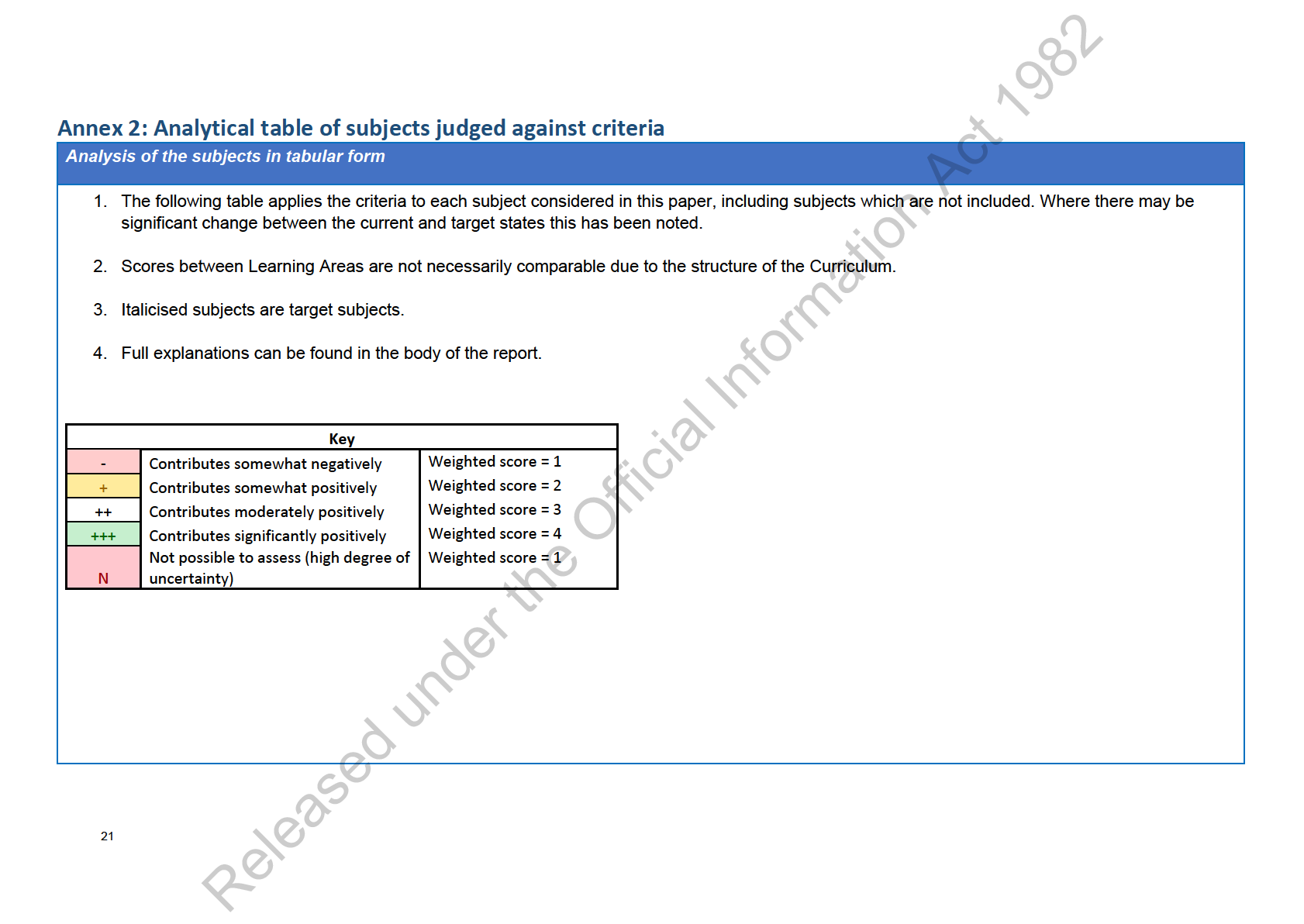
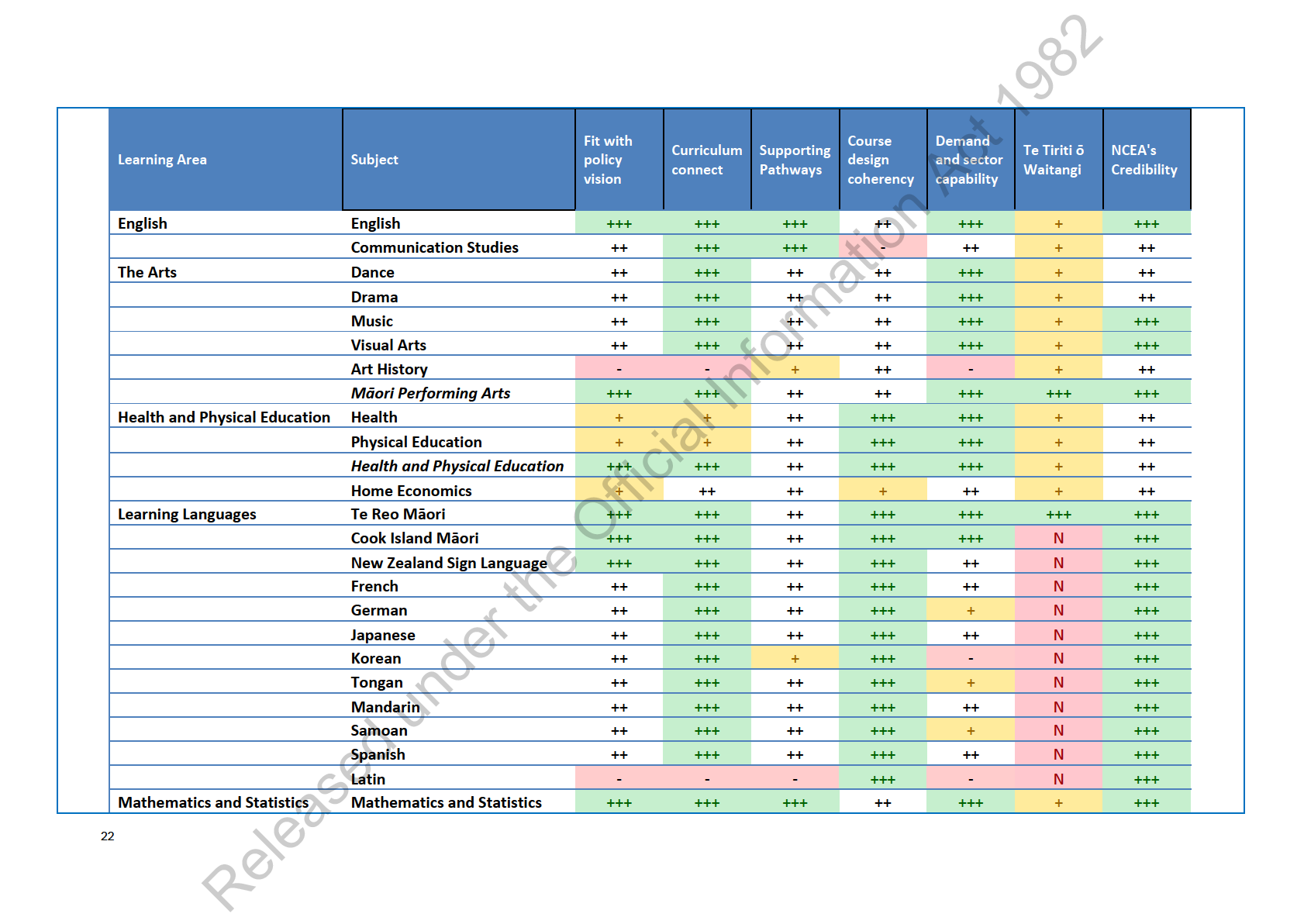

under the Official Information Act 1982
24
Released




























